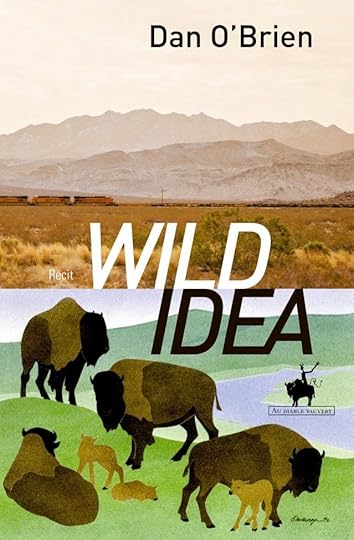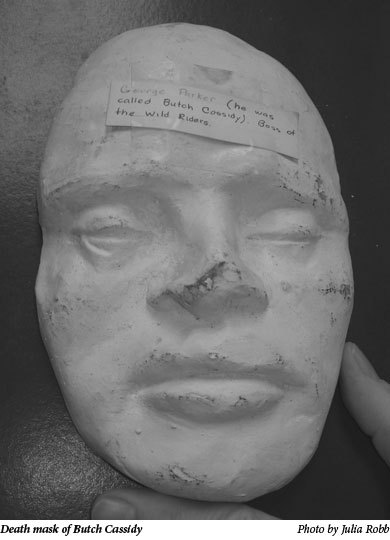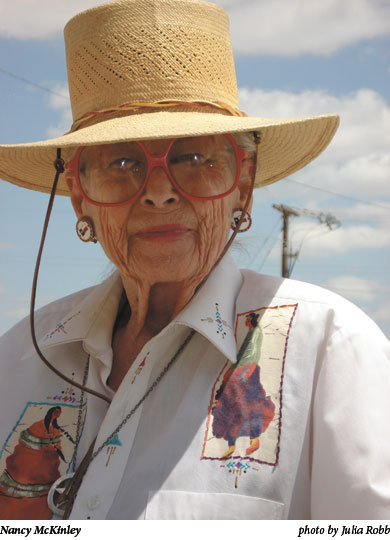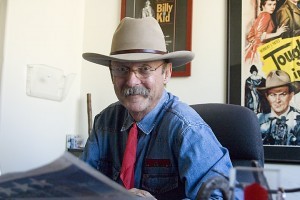Julia Robb's Blog, page 4
January 19, 2016
Greg Michno, Sand Creek and The End of History
Mr. Michno is one of the foremost historians of the American West, having researched and written more than a dozen books about the West. But Michno is not one of the foremost historians because he wrote the books, but because he does not compromise: He tells the truth whether readers like that truth or not.
 Mr. Michno’s last book, Battle At Sand Creek: A Military Perspective, does not feed us the usual dose of outrage at what happened at Sand Creek (Nov. 29, 1864), but a more balanced perspective.
Mr. Michno’s last book, Battle At Sand Creek: A Military Perspective, does not feed us the usual dose of outrage at what happened at Sand Creek (Nov. 29, 1864), but a more balanced perspective.
Now, he has expanded the first Sand Creek book and published The Three Battles of Sand Creek: The Cheyenne Massacre in Blood, in Court, and as the End of History.
The book will be released in April, and readers can order it now through Amazon.
Robb: How does The Three Battles of Sand Creek: The Cheyenne Massacre in Blood, in Court, and as the End of History differ from The Battle of Sand Creek: A Military Perspective?
Michno: Battle at Sand Creek: The Military Perspective (Upton & Sons, 2004) was a detailed narrative history of the events preceding the Sand Creek affair and an extensive treatment of the two-day fight/massacre. I tried to present the military perspective to balance the prevailing pro-Indian viewpoint in vogue for the past half-century or more.
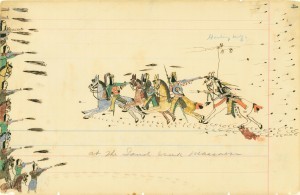
Sand Creek, by Howling Wolf
The evidence actually shows that the affair did have some aspects of a battle, although one accompanied by dreadful atrocities.
What I found out was that few people wanted to entertain the non-standard perspective.
Instead, I decided to try to find out what made the Sand Creek story so divisive and why facts do not seem to matter.
The Three Battles of Sand Creek (SavasBeatie, 2016) begins with a factual treatment of the two-day incident, but the focus, I believe, is in the third section, with an analysis of eyewitness testimony and memory. We find that eyewitnesses, as police have known for years, can be extremely unreliable at “remembering” what they allegedly saw. Memories are invented, tentative, and malleable; they can be created and destroyed like Frankenstein’s monster.
Since we filter the world through individual lenses, facts are personal perceptions, true only for the person doing the filtering. It is a postmodernist view, without a universal narrative, and truth is illusory. It may sound trite, but Sand Creek is in the eye of the beholder, and no amount of facts will change one’s mind. We can only see what we already believe.
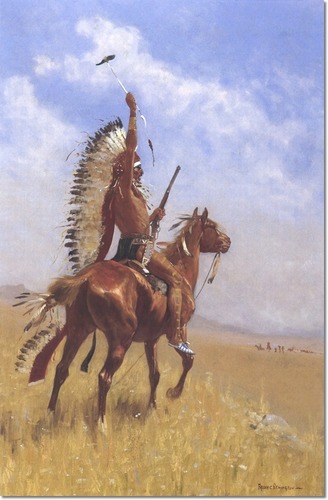 Robb: According to your first book on this subject, history has overlooked that the Colorado troops at Sand Creek sustained 76 casualties, the sixth highest in the 1,450 battles fought between whites and Indians between 1850-1890, that the Cheyenne had been fighting and raiding all summer and into the fall, that warriors who had been raiding were living in the village when it was hit by soldiers, and other pertinent details.
Robb: According to your first book on this subject, history has overlooked that the Colorado troops at Sand Creek sustained 76 casualties, the sixth highest in the 1,450 battles fought between whites and Indians between 1850-1890, that the Cheyenne had been fighting and raiding all summer and into the fall, that warriors who had been raiding were living in the village when it was hit by soldiers, and other pertinent details.
But you indicated that few people believed these facts made a difference, or even agreed they were facts at all. Has anything changed since publication?
Michno: The number of soldier casualties always seems to be undercounted, which contributes to the perception of a one-sided fight. A thorough search of existing records, including remembrances and newspapers, show 25 soldiers were killed and 51 wounded, which is very high for western Indian war fights.
People have argued that the high number of soldier casualties was because they were self-inflicted by “friendly fire.”
Actually, we have descriptions of 29 of the wounds: 16 were from arrows and 13 were from bullets. The soldiers did not pick up bows and arrows and shoot themselves. Also, friendly fire is a two-way street: both sides are just as apt to mistakenly hit their own.
Many of these Indians had been raiding all summer and were in the village. But many of them were innocent. Did the women and children aid and abet the warriors? Very likely. If so, were they legitimate targets?
Consider, however, that white women and children on the frontier were killed by Indians in the same manner. They were either all legitimate targets, or none of them were. 
Do any of these facts make a difference? Probably not. Remember, we are social animals and we connect to personal narratives; we love storytelling; we love anecdotes more than statistics. It doesn’t matter if there were 76 soldier casualties—that’s just a statistic. The mutilated, pregnant Indian woman is the headline. There’s our anecdote. That is our human nature; that is our gut talking.
Carl Sagan was once asked what his “gut feeling” was. He answered that he didn’t think with his gut, he used his head. Many of us don’t.
I don’t believe that anything has changed in the perception of Sand Creek, or that anything will. What I hope is that those who read the book will possibly come away with some understanding as to why they will not change their minds, no matter what the facts are.
Robb: You’ve indicated that our prejudices decide what we believe to be true. Why is that?
A. We are all controlled by subconscious psychological processes in our brains, some which may be from nature, but most from nurture; learned from our parents, teachers, churches, friends, workplace, and countless interactions. Free will may be less of a factor than determinism.
Our preconceptions, our prejudices are ingrained. We may think and act as we do not from uninhibited choice, but from an over-active amygdala. This brain area, associated with “fight or flight” and “gut” reaction, probably has more subconscious control over our thoughts and actions than we would like to admit. It’s just another reason why facts don’t make a difference.
Robb: What did you find out investigating the contradictory testimony, and what was said in court?

Col. John M. Chivington
Michno: The Denver Military Commission, the Congressional Inquiry in Washington, and Senator James Doolittle’s Commission, all sought “to inquire into and report all the facts connected with the late attack” at Sand Creek. They also wanted someone to blame.
The Denver Commission exemplified the proceedings. John Chivington, who was the defendant even though he was not supposedly on trial, objected to questions and proceedings and was sustained 37% of the time; Sam Tappan, who hated Chivington and was head of the tribunal, sustained 93% of his own motions. In addition, there were nearly 700 soldiers in the Sand Creek campaign, but only 59 were questioned, and only 28 were eyewitnesses of the actual events.
One might think that the majority of witnesses chosen would have been people who had actually been there.
Extremely poor question framing had a great impact. In Ben Wade’s committee, for instance, D. W. Gooch asked John Evans if there was “any justification for the attack made by Colonel Chivington on these friendly Indians…?” William Windom asked him if there was “any palliation or excuse for that massacre,” and James Doolittle asked Sam Colley, “Was it the First Colorado Regiment that joined in this massacre, or was it the one-hundred-day men that were raised?”
Whether or not the Indians were friendly or if they were massacred were the very things the inquiries were supposedly designed to find out, but the answers were implicit in the questions.
As for the testimony, it was so completely contradictory, that one might believe the witnesses were describing different events. Not only did different witnesses give disparate stories, but sometimes the same witnesses told different stories.
For instance, one of the key witnesses was Capt. Silas Soule. He said, “I refused to fire,” but he also said Major Anthony ordered him to fire and “some firing was done.” When Soule was asked if he saw any soldiers scalping or mutilating Indians, he once testified, “I did,” and another time he testified, “I think not.”

Captain Silas Soule
Senator Doolittle’s report is often cited as the final explanation as to what happened: lawless white men always caused all the trouble and Sand Creek was a massacre of peaceful Indians who were under army protection. Another commissioner, Oregon Senator James W. Nesmith, wrote a sub-report with a totally different view. He called the Indians the instigators of all the trouble because of “their constitutional and ingrained tendency to rob and murder.”
Nesmith’s view was just as biased as Doolittle’s—the former’s villains were Indians, and the latter’s were whites. Doolittle of Wisconsin, and Nesmith of Oregon—Easterners and Westerners—saw the facts through different lenses. Was one right and one wrong, or were they both right, or both wrong?
It could be that the evidence was completely irrelevant because they were predisposed to come to the conclusions they did regardless of the facts. Confirmation bias forced them to reinforce one set of “truths” and discount the other. One man’s fact is another man’s falsehood.
Robb: Why is this the “End of History?”
Michno: There has been much written about history’s demise. In The Republic, Plato talked about the “dialectic,” which was a type of logical process of reasoned argumentation in which opposing viewpoints are eventually solved, ending the controversy. The idea was refined by the German philosopher G. W. F. Hegel. The famous Hegelian Dialectic (logical argument) posits that every attempt to formulate conceptions about the world (thesis) is contradicted by another formulation (antithesis), and the conflict between the two is eventually resolved (synthesis). The dialectic is ended—for a time—for internal inconsistencies will eventually serve as a thesis for a new dialectic.
Will the dialectic ever lead us to nirvana? Its course seems to be progressive and linearly ascendant, because each new thesis represents an advance over the previous thesis until an endpoint is reached. In the final culmination there will be a complete objectification of thought and mind into a basic independent entity, devoid of all personality. The absolute mind becomes the real universe, marching toward full self-realization. It must be like Star Trek’s Dr. Spock trying to do a mind-meld with the universe.
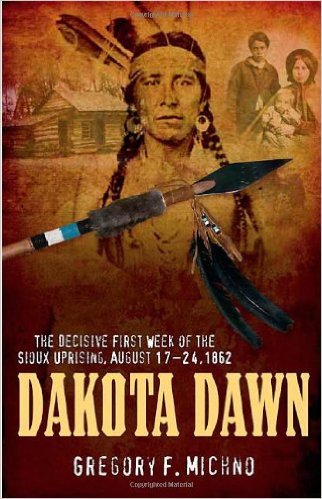 What would happen if the grand finale of universal enlightenment closed the curtain? For Hegel, without the active opposition of an antithesis working through the dialectic, existence would be hollow. Man would have no reason to live without a search for Reason. The entire scheme collapses. Hegel, followed by Nietzsche, are blamed for setting us on the road to postmodernism.
What would happen if the grand finale of universal enlightenment closed the curtain? For Hegel, without the active opposition of an antithesis working through the dialectic, existence would be hollow. Man would have no reason to live without a search for Reason. The entire scheme collapses. Hegel, followed by Nietzsche, are blamed for setting us on the road to postmodernism.
Nevertheless, Hegel’s Dialectic seems viable. It proceeds forward a step at a time, each new synthesis an advancement over the preceding, until the final goal of absolute Reason is realized—the end of history—which is nothing more than cognitive dissonance and its reduction.
In our postmodernist world there will also be an end of history, but only because there will be no universal truth to discover; the continuous dissonance and its constant reduction is on a personal, individual, never ending treadmill.
Discovering the final truth would end history as much as spinning in a perpetual circle, trapped in a maze with no outlet, which is the actual case when we continuously battle our psychological demons, searching for that ever elusive stasis.
Dialectic and dissonance use the same ladder. History will not end because we have reached universal Reason, it will end because we will never even agree on the rules with which to begin the search. We are in a constant dissonance-reducing battle with history either to forget it or sugar-coat it. Ours is a history filled with prejudice, intolerance, hatred, and war. We do not want to remember it as it truly was.
The act of repainting our own history is what we find on a macro scale, since that is exactly what we do with our memories on a micro scale. In the Sand Creek example, there is a constant argument and no synthesis ever occurs because the thesis-antithesis is never discussed in terms of fact, but molded while under the control of preconception, prejudice, false memory, confirmation bias, internal belief systems and more; thus there can be no valid synthesis, no reduction of dissonance, and in effect, it represents the end of all practical history.
History ends in a well of frustration among biased, eternally bickering minds. 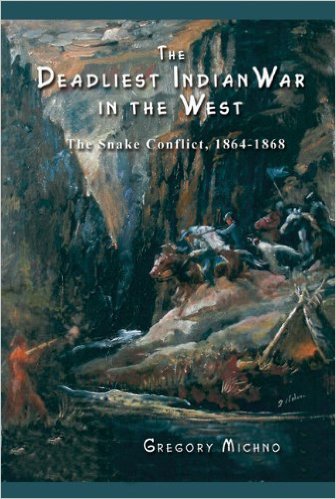
And if you believe that, I want to sell you the Brooklyn Bridge.
Robb: Do your books sell? They are usually so different in fact and opinion than other books on the subject.
Michno: Certainly they sell, but “how many” is the question. None of them have been printed and promoted by the big New York publishers, which is where the publicity, sales, and money are to be found. So I rationalize: I would rather write about a few esoteric topics that interest me than do the same old stuff that has been done hundreds of times. Although I am guilty of writing about some of these topics, does anyone really need another book about Custer or the Little Big Horn?
I have discussed the public’s reading preferences with several agents and authors. The consensus seems to be that there are about one dozen western history topics/subjects that New York will print. They include Custer, Crazy Horse, Sitting Bull, Geronimo, Billy the Kid, Jesse James, Wild Bill Hickok, Buffalo Bill, the Little Big Horn, the Alamo, and the like.
If the subject does not fall into one of those frameworks, it will not be a money-making proposition. New York knows that the American public has very limited interests and imagination. We like our traditional heroes and villains, who all belong to the mythic ideal of American exceptionalism, and we will seldom venture out into uncharted, uncomfortable territory.
The old myths have failed and faded, but New York still prints them—and will until a new mythology comes along.
Robb: It seems there is an ever enlarging strain of biased information against 19th century white settlers and the Army. Why is this?
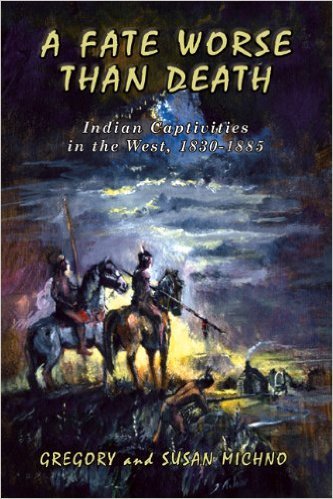 Michno: We started seeing this change more than a half century ago, when cherished myths of American exceptionalism were being seriously questioned.
Michno: We started seeing this change more than a half century ago, when cherished myths of American exceptionalism were being seriously questioned.
The rumblings were in the civil rights and women’s rights movements, and the Viet Nam War protests. The military-industrial complex was seen as avaricious and evil. It was all a part of postmodernism, where universal, happy historical narratives were seen as unrealistic and only a tool of authority. Those who owned the discourse held the power.
When individual, minority, ethnic, and gender narratives proliferated, the Davy Crockett-John Wayne image was shattered. The “Spaghetti Westerns” were a product of the times—the good cowboy image was forever tarnished. Movies like Little Big Man or Soldier Blue, or books like Bury My Heart at Wounded Knee were part of the Zeitgeist. The white settlers and the army no longer wore the white hats.
It is all a part of the ongoing process of historical revision. History changes with the times. People re-write their history to serve their own purposes. It has been going on forever. Perhaps we were due for the change. Those white settlers and cavalrymen were heroes only to a specific segment of the population. Now, those once left out are having their turn. Perhaps it is a good thing.
The idea of American exceptionalism, of spreading Christianity and democracy all over the world may be best relegated to a distant past, because it is no longer relevant, or helpful. And it may make more enemies than friends.
Robb: Are you working on any new projects? 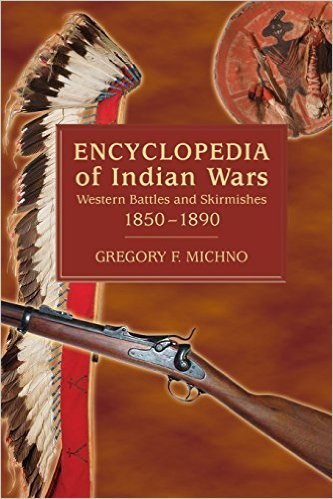
Michno: Yes. I recently finished Smoke over the Sangre de Cristo: Indian Depredation Claims and the Ute-Jicarilla War, 1849-1855. Oklahoma is currently reviewing it. Here, I found that a major reason for our Western Indian wars were the depredation claim sections in the various Trade and Intercourse Acts.
The fact that we allowed people to file claims against Indians with little proof required, and no penalties for false accusations, led to widespread fraud. Whites filed false claims, impelled the militia or army to investigate and chastise the marauders, innocent people were attacked, the inevitable retaliation ensued, and it snowballed into a progressive succession of conflicts.
Studying the claims and the investigations, I found scores of instances where the military searched for alleged culprits, only to find the reports extremely exaggerated or completely bogus. I found more than fifty officers’ reports that literally said that the claimants were liars.
False accusations actually led to war with the Jicarilla and Ute in New Mexico and Colorado during the period in question.
Understanding this underlying conflict between a skeptical military trying to keep the peace and avaricious frontiersmen wanting to make a dollar by fair means or foul, led to the start of another manuscript (title undecided) in which the army’s main adversary during the westward movement was not the Indian, but the frontier settler.
You see, we are constantly in a process of revision. Maybe Voltaire was right when he said: “History is a pack of lies we play on the dead.”

The post Greg Michno, Sand Creek and The End of History appeared first on .
December 18, 2015
The Captive Boy, Comanches and Me
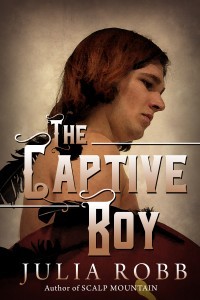 The Captive Boy is now for sale at Amazon.
The Captive Boy is now for sale at Amazon. The novel begins when August Shiltz is recaptured by the Fourth U.S. Cavalry, after having been held captive by the Comanche since he was nine years old.
You can buy this book at Amazon, at http://www.amazon.com/gp/product/B019HQO0GC?keywords=The%20Captive%20Boy&qid=1450466298&ref_=sr_1_6&sr=8-6
Chapter One
With the Fourth Cavalry in Texas: A Memoir of The Indian War, By Joseph Finley Grant, Reporter and Illustrator for Frank Leslie’s Illustrated Newspaper
I was sitting by Col. Theodore (Mac) McKenna’s desk when Privates Wilson and Smith dragged the kid through the door.
They wrestled him to a chair and held him down, trying to tie him up while he fought them, their hands 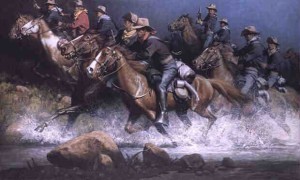 slipping on his greased up skin.
slipping on his greased up skin.
The kid wasn’t wearing clothes to speak of, just a breechclout barely covering his privates and deerskin leggings over his tattered moccasins.
Wood smoke, hot sweat and buffalo robe–which smells like mangy dog–radiated off the boy like heat off a campfire.
Breathing was difficult, even with the window open.
You usually smelled that particular combination of foul odors when parleying in some benighted Comanche lodge.
Finally, Major Sam Brennan and Sergeant-Major Pruitt helped, and the four of them managed to grab the boy by the shoulders and hold him down in the chair.
Even then, the kid thought his name was Eka Papi Tuinupu, or red-headed boy; but he was really August Shiltz, son of kraut-eating immigrants who were farming near Fredericksburg when they were murdered and their son taken.
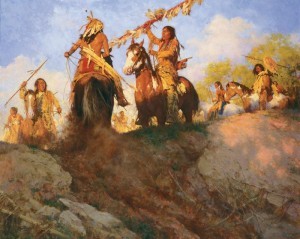 A neighbor (if you can call someone who lives fifteen miles away a neighbor) took some food to the family, as the Shiltz’s were hard-luck people, and found everyone except August lying in front of the smoking cabin.
A neighbor (if you can call someone who lives fifteen miles away a neighbor) took some food to the family, as the Shiltz’s were hard-luck people, and found everyone except August lying in front of the smoking cabin.
Their naked bodies were white in the sun, scalped, mutilated, the woman and girls’ raped–which was what the savages always did.
I never understood how the army spotted August during the raid on the Comanche village, as it was easy to mistake him for a Quahadi (what this band of Comanches call themselves, antelope people).
Sun had darkened his skin and his red braids were black with dirt and grease.
Only a close look revealed the Teutonic face; his long nose and long jaws below sharp cheekbones, the thin lips and narrow, defiant blue eyes.
Also, at sixteen, he was already taller and heavier than most fully-grown Comanche warriors.
On horseback, the Comanches were magnificent, but standing on level ground with the rest of us they usually failed to exceed five feet six inches tall, much like jockeys one sees at Saratoga, and their bowed legs made them appear even shorter.
August was already four or five inches taller than most of his compatriots.
I’ve been to the university at Heidelberg and seen students dueling–their facial scars are marks of honor and proof of their dubious manhood–and August looked just like them; minus the scars.
As soon as the men dragged August into Mac’s office, I snatched my sketching pencils from my pocket and went to work.
I still have that sketch, which came in handy a few years later when I wrote about the war: August, perching on the chair like a bound hawk, his eyes slit in rage and fear.
Colonel McKenna watched the boy, his hands folded on his desk, light from the window shining on his
blue cavalry uniform, glinting off the silver eagles sitting on his shoulders. 
Army command sent McKenna to Fort Richards eight months previously to command the Fourth Cavalry. He fought in the War of the Rebellion and was a decorated war veteran, wounded six times and brevetted seven times on the field, climbing from second lieutenant to colonel to brevet major general: Not even George Custer was promoted that rapidly.
Brevet means holding a rank without being given that rank’s responsibilities and pay; which was a way to reward good officers without actually doing anything for them.
Mac was a handsome man. He had long, thin jaws, a full, well-curved mouth and a square chin. But he also had a perpetual squint around his blue eyes, as if his head hurt.
Although he looked calm that day, Mac McKenna was probably not calm all the way through.
Sometimes Mac’s hands shook, like he vibrated inside, though he carried himself like an iron rod on parade. He had a pleasant tenor voice, but it was controlled, as if his feelings were in the guardhouse and he had thrown the key away.
His men were in terror of him, and for excellent reasons.
“Are you August Shiltz?” Mac asked.
No reaction.
Mac said to Ben Washington, the black Seminole scout standing by his desk, “Tell August if he stops struggling he will not be restrained.”
Now here’s something odd. When Ben first came in, the kid straightened to attention and said something urgent in Comanche.
I assumed they knew each other.
Ben answered him, and the kid looked confused.
Then Ben mumbled something else to the boy, pushing Comanche words out of his chest like rocks, and August quieted.
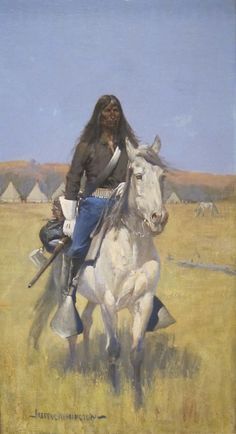 You would never mistake Ben for a soldier, or for a regular Seminole, for that matter. The Black-Seminoles were descended from runaway slaves who took refuge with the Seminoles in Florida and sometimes intermarried.
You would never mistake Ben for a soldier, or for a regular Seminole, for that matter. The Black-Seminoles were descended from runaway slaves who took refuge with the Seminoles in Florida and sometimes intermarried.
Ben was typical of that ilk. Kinky hair fell to his shoulders but his skin was lighter than his slave ancestors. And he had slim lips and Indian cheekbones perching under his eyes like iron bars.
Ben would have been nice-looking, for a half-breed, but a round scar on his face puckered his left cheek and I suspect some teeth were missing. Obviously shot from his mouth.
Mac sat with his hands clasped on his desk, staring at the kid.
That was another thing about Mac, he didn’t exude warmth or empathy. Cross him in any way and you would live to regret it.
“You have been identified as August Shiltz, taken from your father’s farm when you were nine years old,” Mac said, waiting while Ben translated.
August looked coiled to pounce.
“The raiders killed your parents and your sisters. Do you have other family here in Texas?”
Silence.
“How much English do you remember?”
Silence.
I pulled out my notebook and writing pencil.
This might make two columns in the newspaper: White Child Rescued From Savages. Years of Brutal 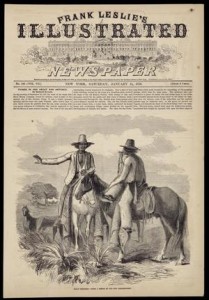 Captivity.
Captivity.
I usually wrote about the joyous reunions though the joyous reunions were usually on the relatives’ side.
If captives lived with a tribe more than five years, once we got them back they didn’t remember their own mothers, assuming those mothers escaped being raped to death in the raid.
Assuming anyone survived.
Assuming the captive was adopted into the tribe.
If you were a woman and not adopted, life was a hell of sexual slavery and endless toil.
Sometimes returned captives became good white citizens: A few pined away until they died, longing for God knows who or what.
“Ask the boy if he remembers his white name or his family,” Mac said.
After Ben translated, August sneered and rattled back.
“He says he is Comanche, not white,” Ben said, his expression unchanged.
Mac wasn’t surprised. None of us were. That’s what captive kids usually said.
 “Tell him the raiders who killed his family captured him on December 25, 1864.”
“Tell him the raiders who killed his family captured him on December 25, 1864.”
August shook his head, his face indifferent.
“Tell him the squaws we took in the raid confirm he was a captive.”
August shook his head.
“Ask him to explain his eye color.”
“Tabernacle my father,” August said, blurting the words in English.
That was startling, as we believed the boy had forgotten his English.
Mac leaned back in his chair, contemplating the kid and snapping his stumps, the three partially amputated fingers on his left hand. Everything was gone below the first joints, thanks to rebel artillery.
The men called the colonel, among other things, “Three-finger Jack.”
They also referred to him as “hard ass,” and they weren’t joking.
While McKenna pondered, the kid jumped from his chair and dove for the open window behind Mac’s desk. 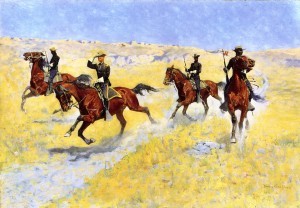
A flash and he was almost gone, but Mac threw himself at the kid and caught his leg, then the troopers grabbed the other leg and they pulled him back inside.
“Tie him to the chair,” Mac told his men, and one of them reached for a lariat and wrapped it around the boy until he couldn’t move.
August’ eyes were wide, his pupils dilated until they looked black.
“Do you remember if your family got mail, letters?” Mac asked, as if nothing had happened.
“Tabernacle my father.”
“I can’t allow you to run back to the Comanches.”
“I want.”
Mac shook his head, glancing at Sam Brennan: “Remind me Major. Where did the Comanche capture this boy?”
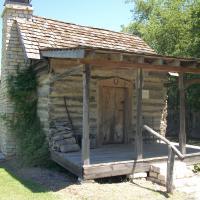 Sam glanced at Mac, his eyes brimming with good-humored interest at the situation (as he viewed most situations), and said, “His parents were farming beyond the safe line sir, twenty miles west of Fredericksburg. We believe the Comanche fired the family’s cabin and then killed them when they ran outside.”
Sam glanced at Mac, his eyes brimming with good-humored interest at the situation (as he viewed most situations), and said, “His parents were farming beyond the safe line sir, twenty miles west of Fredericksburg. We believe the Comanche fired the family’s cabin and then killed them when they ran outside.”
“No reported sightings until now?”
“No sir.”
“Do you have relatives in Germany,” Mac asked the boy.
Silence.
Mac turned to Ben and said, “Explain Germany to him, that it’s a country across a big body of water, tell him that’s where his parents came from.”
Ben translated.
“I Quahadi,” August said.
“Major, what would you do with August, had you the decision?” Mac asked Sam.
“Send him to the reserve Sir.”
“He’s not a Comanche.”
“Find a foster family.”
“He would run the first day.”
“That would be his decision. He’s a big boy.”
“We don’t need another fighting Comanche.” 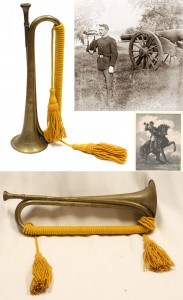
You could watch Mac’s eyes and see him thinking, planning, and you would never mistake the colonel for anyone else. Nothing escaped his attention.
McKenna snapped out orders and woe was the trooper who failed to muck out a stall or neglect his weapons.
Woe to the officers who did not turn in reports, or did not properly drill men, or allowed his troopers to sleep in the saddle on a long patrol.
Patrols could last months, and troopers could ride thirty-six hours straight when they were on the hunt. You couldn’t let them sleep or they would fall behind the column.
By the time they were found, they were usually dead.
A trooper went to sleep on patrol a few months previously and fell out of his saddle.
Back at Richards, Mac ordered the man spread-eagled on an artillery cartwheel, and then left that poor trooper on the wheel until the bugle blew retreat.
The kid stared at Mac’s hair, and Mac watched the kid stare at his hair.
Mac had the kind of brown hair that has red glints in it, and those glints shone in the sunlight pouring in the window behind him.
 “Pruitt, do you remember those troopers I sent to the guardhouse?” Mac asked the sergeant major, an older man whose stomach stuck out in front of him, though hardly more than mine, I venture to guess.
“Pruitt, do you remember those troopers I sent to the guardhouse?” Mac asked the sergeant major, an older man whose stomach stuck out in front of him, though hardly more than mine, I venture to guess.
“Which ones?”
“They were drunk in the barracks and peed in the wood stove.”
“Yes sir, Privates Johnny O’Donovan and Abner Bullis.”
“What is their sentence?”
“Two weeks, then kitchen duty until discharge.”
“Release and reassign. I want them to guard our young man wherever he goes. And he is forbidden to walk off post. And tell the troopers if August escapes, they will carry a log chained to their shoulders until I say otherwise.”
“Sir, not O’Donovan, I need him for my team. Please, sir.”
Pruitt loved his baseball team.
If McKenna had a favorite besides Sam Brennan, it was Pruitt. Both served under him in the war, and he needed both of them to run the garrison. 
“Very well, release O’Donovan, assign Bullis and any other trooper to our young man, and find two Sunday reliefs.”
“Where will we quarter him?” Sam asked.
“Put him in the room next to mine, at my quarters. Put a cot in there. Board up the window and order Bullis to sleep immediately outside the door.”
Sam looked amazed.
The boy understood. He jerked the chair, it toppled over, and his nose slammed against the splintered wood floor.
Sam and the troopers lifted him the chair and blood ran from the kid’s nose to his neck and chest, like the river of blood yet to come.
“Major, wipe his nose,” Mac told Sam.
Sam took off his neckerchief and swiped the kid’s face, but blood trickled down his lips.
The kid sucked the blood into his mouth, leaned as far forward as the lariat permitted and spit blood at Mac.
“I Quahadi,” the kid said, his nose and mouth running with blood.
Mac did not flinch, though blood splattered his desk.
After a moment, Mac said, “And Major, enroll August in the post school. I want him bathed and clothed like a white boy. I want him eating at the enlisted men’s mess.”
The troopers dragged August from the office, and everyone else filed from Mac’s office except me.
Nobody noticed me. They had no idea what an Eastern newspaper could do to them.
I sat looking out the window, wondering what kind of story to write.
It was April, the rainy season had lingered and the prairie was green.
Richards sat on a rise where the wind was always moving, and you could see up to a mile.
 Cottonwood trees dotting the creek were leafed out, their heart-shaped leaves shining in the sun, and I could see miles of prairie flowers beyond the thin curve of green water.
Cottonwood trees dotting the creek were leafed out, their heart-shaped leaves shining in the sun, and I could see miles of prairie flowers beyond the thin curve of green water.
Looking for anything else of beauty was futile.
Even the post buildings were crude; frame buildings so frail the wind shook them and sent never-ending dust through cracks in the warped boards; picket huts made from long cottonwood sticks, mud packed between the sticks, with sod roofs sprouting grass each spring; framed-up tents that snapped in the wind, threatening to fly away; adobe storehouses and shops.
One unfortunate second lieutenant and his wife (just transferred from the east, and what must they have thought of Richards) were forced to live in a converted chicken coop until another officer vacated his quarters.
That’s true and not in the least hyperbole.
I assure you, there was nothing decent to live or work in.
Picket buildings crawled with scorpions, spiders and snakes. Scorpions and dirt fell from the ceiling. Nasty places.
The only real building was the two-story stone hospital. 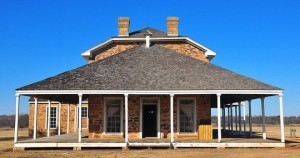
It wasn’t long before Mac appeared outside, playing with his pet buffalo calf.
I turned a new page in my sketchbook and began to draw the colonel and the calf. A few strokes and there he was, a slight man, severely underweight due to his war wounds, taller than the calf but a lot thinner.
At two months, the calf weighed at least two hundred pounds.
At the colonel’s orders, one of the troopers was keeping the orphan alive by feeding it some kind of mash.
The calf butted its woolly head on Mac’s shoulder, and Mac staggered backward.
As far as I could tell, Mac was attached to the beast.
McKenna rubbed the calf’s head and reached in his pocket, pulled something out and fed it to the buffalo, then walked toward his quarters.
The post The Captive Boy, Comanches and Me appeared first on .
The Captive Boy and Me
 The Captive Boy is now for sale at Amazon.
The Captive Boy is now for sale at Amazon. The novel begins when August Shiltz is recaptured by the Fourth U.S. Cavalry, after having been held captive by the Comanche since he was nine years old.
You can buy this book at Amazon, at http://www.amazon.com/gp/product/B019HQO0GC?keywords=The%20Captive%20Boy&qid=1450466298&ref_=sr_1_6&sr=8-6
Chapter One
With the Fourth Cavalry in Texas: A Memoir of The Indian War, By Joseph Finley Grant, Reporter and Illustrator for Frank Leslie’s Illustrated Newspaper
I was sitting by Col. Theodore (Mac) McKenna’s desk when Privates Wilson and Smith dragged the kid through the door.
They wrestled him to a chair and held him down, trying to tie him up while he fought them, their hands  slipping on his greased up skin.
slipping on his greased up skin.
The kid wasn’t wearing clothes to speak of, just a breechclout barely covering his privates and deerskin leggings over his tattered moccasins.
Wood smoke, hot sweat and buffalo robe–which smells like mangy dog–radiated off the boy like heat off a campfire.
Breathing was difficult, even with the window open.
You usually smelled that particular combination of foul odors when parleying in some benighted Comanche lodge.
Finally, Major Sam Brennan and Sergeant-Major Pruitt helped, and the four of them managed to grab the boy by the shoulders and hold him down in the chair.
Even then, the kid thought his name was Eka Papi Tuinupu, or red-headed boy; but he was really August Shiltz, son of kraut-eating immigrants who were farming near Fredericksburg when they were murdered and their son taken.
 A neighbor (if you can call someone who lives fifteen miles away a neighbor) took some food to the family, as the Shiltz’s were hard-luck people, and found everyone except August lying in front of the smoking cabin.
A neighbor (if you can call someone who lives fifteen miles away a neighbor) took some food to the family, as the Shiltz’s were hard-luck people, and found everyone except August lying in front of the smoking cabin.
Their naked bodies were white in the sun, scalped, mutilated, the woman and girls’ raped–which was what the savages always did.
I never understood how the army spotted August during the raid on the Comanche village, as it was easy to mistake him for a Quahadi (what this band of Comanches call themselves, antelope people).
Sun had darkened his skin and his red braids were black with dirt and grease.
Only a close look revealed the Teutonic face; his long nose and long jaws below sharp cheekbones, the thin lips and narrow, defiant blue eyes.
Also, at sixteen, he was already taller and heavier than most fully-grown Comanche warriors.
On horseback, the Comanches were magnificent, but standing on level ground with the rest of us they usually failed to exceed five feet six inches tall, much like jockeys one sees at Saratoga, and their bowed legs made them appear even shorter.
August was already four or five inches taller than most of his compatriots.
I’ve been to the university at Heidelberg and seen students dueling–their facial scars are marks of honor and proof of their dubious manhood–and August looked just like them; minus the scars.
As soon as the men dragged August into Mac’s office, I snatched my sketching pencils from my pocket and went to work.
I still have that sketch, which came in handy a few years later when I wrote about the war: August, perching on the chair like a bound hawk, his eyes slit in rage and fear.
Colonel McKenna watched the boy, his hands folded on his desk, light from the window shining on his
blue cavalry uniform, glinting off the silver eagles sitting on his shoulders. 
Army command sent McKenna to Fort Richards eight months previously to command the Fourth Cavalry. He fought in the War of the Rebellion and was a decorated war veteran, wounded six times and brevetted seven times on the field, climbing from second lieutenant to colonel to brevet major general: Not even George Custer was promoted that rapidly.
Brevet means holding a rank without being given that rank’s responsibilities and pay; which was a way to reward good officers without actually doing anything for them.
Mac was a handsome man. He had long, thin jaws, a full, well-curved mouth and a square chin. But he also had a perpetual squint around his blue eyes, as if his head hurt.
Although he looked calm that day, Mac McKenna was probably not calm all the way through.
Sometimes Mac’s hands shook, like he vibrated inside, though he carried himself like an iron rod on parade. He had a pleasant tenor voice, but it was controlled, as if his feelings were in the guardhouse and he had thrown the key away.
His men were in terror of him, and for excellent reasons.
“Are you August Shiltz?” Mac asked.
No reaction.
Mac said to Ben Washington, the black Seminole scout standing by his desk, “Tell August if he stops struggling he will not be restrained.”
Now here’s something odd. When Ben first came in, the kid straightened to attention and said something urgent in Comanche.
I assumed they knew each other.
Ben answered him, and the kid looked confused.
Then Ben mumbled something else to the boy, pushing Comanche words out of his chest like rocks, and August quieted.
 You would never mistake Ben for a soldier, or for a regular Seminole, for that matter. The Black-Seminoles were descended from runaway slaves who took refuge with the Seminoles in Florida and sometimes intermarried.
You would never mistake Ben for a soldier, or for a regular Seminole, for that matter. The Black-Seminoles were descended from runaway slaves who took refuge with the Seminoles in Florida and sometimes intermarried.
Ben was typical of that ilk. Kinky hair fell to his shoulders but his skin was lighter than his slave ancestors. And he had slim lips and Indian cheekbones perching under his eyes like iron bars.
Ben would have been nice-looking, for a half-breed, but a round scar on his face puckered his left cheek and I suspect some teeth were missing. Obviously shot from his mouth.
Mac sat with his hands clasped on his desk, staring at the kid.
That was another thing about Mac, he didn’t exude warmth or empathy. Cross him in any way and you would live to regret it.
“You have been identified as August Shiltz, taken from your father’s farm when you were nine years old,” Mac said, waiting while Ben translated.
August looked coiled to pounce.
“The raiders killed your parents and your sisters. Do you have other family here in Texas?”
Silence.
“How much English do you remember?”
Silence.
I pulled out my notebook and writing pencil.
This might make two columns in the newspaper: White Child Rescued From Savages. Years of Brutal  Captivity.
Captivity.
I usually wrote about the joyous reunions though the joyous reunions were usually on the relatives’ side.
If captives lived with a tribe more than five years, once we got them back they didn’t remember their own mothers, assuming those mothers escaped being raped to death in the raid.
Assuming anyone survived.
Assuming the captive was adopted into the tribe.
If you were a woman and not adopted, life was a hell of sexual slavery and endless toil.
Sometimes returned captives became good white citizens: A few pined away until they died, longing for God knows who or what.
“Ask the boy if he remembers his white name or his family,” Mac said.
After Ben translated, August sneered and rattled back.
“He says he is Comanche, not white,” Ben said, his expression unchanged.
Mac wasn’t surprised. None of us were. That’s what captive kids usually said.
 “Tell him the raiders who killed his family captured him on December 25, 1864.”
“Tell him the raiders who killed his family captured him on December 25, 1864.”
August shook his head, his face indifferent.
“Tell him the squaws we took in the raid confirm he was a captive.”
August shook his head.
“Ask him to explain his eye color.”
“Tabernacle my father,” August said, blurting the words in English.
That was startling, as we believed the boy had forgotten his English.
Mac leaned back in his chair, contemplating the kid and snapping his stumps, the three partially amputated fingers on his left hand. Everything was gone below the first joints, thanks to rebel artillery.
The men called the colonel, among other things, “Three-finger Jack.”
They also referred to him as “hard ass,” and they weren’t joking.
While McKenna pondered, the kid jumped from his chair and dove for the open window behind Mac’s desk. 
A flash and he was almost gone, but Mac threw himself at the kid and caught his leg, then the troopers grabbed the other leg and they pulled him back inside.
“Tie him to the chair,” Mac told his men, and one of them reached for a lariat and wrapped it around the boy until he couldn’t move.
August’ eyes were wide, his pupils dilated until they looked black.
“Do you remember if your family got mail, letters?” Mac asked, as if nothing had happened.
“Tabernacle my father.”
“I can’t allow you to run back to the Comanches.”
“I want.”
Mac shook his head, glancing at Sam Brennan: “Remind me Major. Where did the Comanche capture this boy?”
 Sam glanced at Mac, his eyes brimming with good-humored interest at the situation (as he viewed most situations), and said, “His parents were farming beyond the safe line sir, twenty miles west of Fredericksburg. We believe the Comanche fired the family’s cabin and then killed them when they ran outside.”
Sam glanced at Mac, his eyes brimming with good-humored interest at the situation (as he viewed most situations), and said, “His parents were farming beyond the safe line sir, twenty miles west of Fredericksburg. We believe the Comanche fired the family’s cabin and then killed them when they ran outside.”
“No reported sightings until now?”
“No sir.”
“Do you have relatives in Germany,” Mac asked the boy.
Silence.
Mac turned to Ben and said, “Explain Germany to him, that it’s a country across a big body of water, tell him that’s where his parents came from.”
Ben translated.
“I Quahadi,” August said.
“Major, what would you do with August, had you the decision?” Mac asked Sam.
“Send him to the reserve Sir.”
“He’s not a Comanche.”
“Find a foster family.”
“He would run the first day.”
“That would be his decision. He’s a big boy.”
“We don’t need another fighting Comanche.” 
You could watch Mac’s eyes and see him thinking, planning, and you would never mistake the colonel for anyone else. Nothing escaped his attention.
McKenna snapped out orders and woe was the trooper who failed to muck out a stall or neglect his weapons.
Woe to the officers who did not turn in reports, or did not properly drill men, or allowed his troopers to sleep in the saddle on a long patrol.
Patrols could last months, and troopers could ride thirty-six hours straight when they were on the hunt. You couldn’t let them sleep or they would fall behind the column.
By the time they were found, they were usually dead.
A trooper went to sleep on patrol a few months previously and fell out of his saddle.
Back at Richards, Mac ordered the man spread-eagled on an artillery cartwheel, and then left that poor trooper on the wheel until the bugle blew retreat.
The kid stared at Mac’s hair, and Mac watched the kid stare at his hair.
Mac had the kind of brown hair that has red glints in it, and those glints shone in the sunlight pouring in the window behind him.
 “Pruitt, do you remember those troopers I sent to the guardhouse?” Mac asked the sergeant major, an older man whose stomach stuck out in front of him, though hardly more than mine, I venture to guess.
“Pruitt, do you remember those troopers I sent to the guardhouse?” Mac asked the sergeant major, an older man whose stomach stuck out in front of him, though hardly more than mine, I venture to guess.
“Which ones?”
“They were drunk in the barracks and peed in the wood stove.”
“Yes sir, Privates Johnny O’Donovan and Abner Bullis.”
“What is their sentence?”
“Two weeks, then kitchen duty until discharge.”
“Release and reassign. I want them to guard our young man wherever he goes. And he is forbidden to walk off post. And tell the troopers if August escapes, they will carry a log chained to their shoulders until I say otherwise.”
“Sir, not O’Donovan, I need him for my team. Please, sir.”
Pruitt loved his baseball team.
If McKenna had a favorite besides Sam Brennan, it was Pruitt. Both served under him in the war, and he needed both of them to run the garrison. 
“Very well, release O’Donovan, assign Bullis and any other trooper to our young man, and find two Sunday reliefs.”
“Where will we quarter him?” Sam asked.
“Put him in the room next to mine, at my quarters. Put a cot in there. Board up the window and order Bullis to sleep immediately outside the door.”
Sam looked amazed.
The boy understood. He jerked the chair, it toppled over, and his nose slammed against the splintered wood floor.
Sam and the troopers lifted him the chair and blood ran from the kid’s nose to his neck and chest, like the river of blood yet to come.
“Major, wipe his nose,” Mac told Sam.
Sam took off his neckerchief and swiped the kid’s face, but blood trickled down his lips.
The kid sucked the blood into his mouth, leaned as far forward as the lariat permitted and spit blood at Mac.
“I Quahadi,” the kid said, his nose and mouth running with blood.
Mac did not flinch, though blood splattered his desk.
After a moment, Mac said, “And Major, enroll August in the post school. I want him bathed and clothed like a white boy. I want him eating at the enlisted men’s mess.”
The troopers dragged August from the office, and everyone else filed from Mac’s office except me.
Nobody noticed me. They had no idea what an Eastern newspaper could do to them.
I sat looking out the window, wondering what kind of story to write.
It was April, the rainy season had lingered and the prairie was green.
Richards sat on a rise where the wind was always moving, and you could see up to a mile.
 Cottonwood trees dotting the creek were leafed out, their heart-shaped leaves shining in the sun, and I could see miles of prairie flowers beyond the thin curve of green water.
Cottonwood trees dotting the creek were leafed out, their heart-shaped leaves shining in the sun, and I could see miles of prairie flowers beyond the thin curve of green water.
Looking for anything else of beauty was futile.
Even the post buildings were crude; frame buildings so frail the wind shook them and sent never-ending dust through cracks in the warped boards; picket huts made from long cottonwood sticks, mud packed between the sticks, with sod roofs sprouting grass each spring; framed-up tents that snapped in the wind, threatening to fly away; adobe storehouses and shops.
One unfortunate second lieutenant and his wife (just transferred from the east, and what must they have thought of Richards) were forced to live in a converted chicken coop until another officer vacated his quarters.
That’s true and not in the least hyperbole.
I assure you, there was nothing decent to live or work in.
Picket buildings crawled with scorpions, spiders and snakes. Scorpions and dirt fell from the ceiling. Nasty places.
The only real building was the two-story stone hospital. 
It wasn’t long before Mac appeared outside, playing with his pet buffalo calf.
I turned a new page in my sketchbook and began to draw the colonel and the calf. A few strokes and there he was, a slight man, severely underweight due to his war wounds, taller than the calf but a lot thinner.
At two months, the calf weighed at least two hundred pounds.
At the colonel’s orders, one of the troopers was keeping the orphan alive by feeding it some kind of mash.
The calf butted its woolly head on Mac’s shoulder, and Mac staggered backward.
As far as I could tell, Mac was attached to the beast.
McKenna rubbed the calf’s head and reached in his pocket, pulled something out and fed it to the buffalo, then walked toward his quarters.
The post The Captive Boy and Me appeared first on .
December 9, 2015
Billy The Kid–To Hell on a Fast Horse
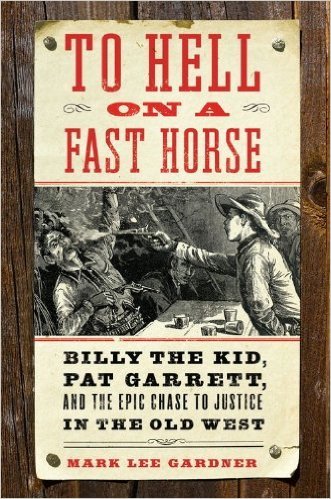
True West magazine named Mark “Best Author” in its annual “Best of the West” issue for 2014.
Moreover, Mark is an award-winning performer of 19th and early 20th-century western music.
Mark’s latest CD is Outlaws: Songs of Robbers, Rustlers, and Rogues,which includes ballads such as “Cole Younger,” “Jesse James,” “Billy the Kid,” and “Sam Bass.”
Question: Mark, when I read To Hell on a Fast Horse I was amazed to find so many facts about Billy that I’ve never seen before, and I thought I knew everything. How did you unearth this much information?
For instance, that Billy had a brother and he visited that brother before he was killed, and that Billy was armed the night he was killed?
Mark Gardner: Mostly it was your traditional “digging” in manuscript archives in various states, from Texas to Utah. I also benefited from amateur and professional historians who have been studying the Kid for decades. Some of these scholars’ vast research collections have ended up in public institutions.
A good example is Leon Metz, who wrote an excellent biography of Pat Garrett in the early 70s. Leon donated all of his papers to the University of Texas at El Paso Library. Making use of his research saved me countless hours of work.
Bob Utley graciously gave me copies of all his research notes on Billy the Kid and the Lincoln County War, which also saved me considerable time. 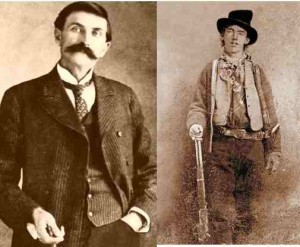
Additionally, I made use of recent technology that has not been previously available to those studying the Kid. I’m referring specifically to the millions of pages of digitized nineteenth-century newspapers that can be accessed online.
Q: Why did you write the book?
Gardner: I wanted to write a book on a western subject that would appeal to a New York publisher. I was fascinated by Pat Garrett’s story and believed I could turn out a fresh biography, but my literary agent suggested I do a dual biography of Garrett and the Kid. It was an excellent suggestion, for the two men are forever linked in history and legend.
 Q: Why does Garrett’s story fascinate you?
Q: Why does Garrett’s story fascinate you?
Gardner: Because he is the more tragic figure of the two. He was a hero throughout the territory after he killed Billy, but as the Kid’s legend grew, Garrett slowly became the villain of the story, a true travesty.
The controversy surrounding Garrett’s 1908 murder near Las Cruces also fascinated me (he was shot in the back of the head while urinating). No one believes that Wayne Brazel, the man tried for killing Garrett, committed the deed. But as for who did, we’re still debating it.
Q: Most authors have assumed the old legend of Pat and Billy once being close friends (or at least buddies) is true, but you discount that. Why?
Gardner: Primarily because Garrett denied they were friends. And I was suspicious of those who said they were bosom buddies. It seemed that the claim of a friendship might have been an attempt to demonize Garrett, make him more of the bad guy: he had turned on his friend and shot him down in the dark. It does make a good story.
(In another interview, Gardner said James E. Sligh, a White Oaks newspaper editor, who came from the same Louisiana parish as Garrett, claimed Garrett told him that while he knew the Kid well, they were neither friends nor enemies: “He minds his business, and I attend to mine.”)
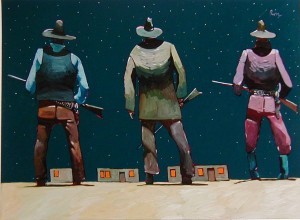
The Arrest of Billy the Kid, by Thom Ross
Q: Many people, including me, have assumed Pat Garrett was a bad man, or at least uncaring and merciless. But you have unearthed a different Pat. He seemed like a good guy. Is that what you think?
Gardner: I do think he was a good guy. That doesn’t mean he didn’t have flaws. He certainly did – we all do. But he deserves tremendous credit for taking on a very dangerous job in becoming sheriff of Lincoln County and hunting down the Kid, something no one else in the territory was willing to do.

Garrett with Apolonaria, his second wife, in 1880
I also look at his family life and see a very loving and caring father and husband. His children absolutely adored him.
Q: Robert Utley told me he didn’t believe Billy was a good person. What do you think?
Gardner: I guess I’m more sympathetic toward the Kid than Bob. Billy lived in a very dangerous place and time. It was sometimes kill or be killed.
It should be pointed out, too, that he was well liked by the native New Mexicans, and we know there were several young ladies, including Paulita Maxwell, who were quite fond of him. He must have had some good in him.

Paulita Maxwell, according to The Ruidoso News. Paulita was Billy’s girlfriend.
Q: I have thought about Billy a lot, and have concluded he was an orphan who had no father to guide him or protect him, so he became rough out of need and vulnerability. What do you think?
Gardner: I think that’s absolutely correct. After his mother’s death, he was on his own and did what he could to get by. If he’d had a stable home life, I don’t believe we’d be talking about a young New Mexico outlaw named Billy the Kid.
Q: Did Billy stay in Lincoln after the Lincoln County War, and after he became a wanted man, because he (unconsciously perhaps) believed it was his home? What do you think? Did his decision make sense?
Gardner: He had at least one sweetheart at Fort Sumner, and he had lots of friends in that area, especially among the Hispanic population. I think Billy felt he was safe there, but I also think that because he had outsmarted New Mexico’s lawmen so many times before, he didn’t believe there was anybody who could get him.
Q: Do you believe the most recent (purported) Billy photo, taken when he and friends were playing croquet, is authentic?
Gardner: It’s indeed a genuine tintype from the nineteenth century, but it’s not Billy and the Regulators.
The February 2016 issue of True West magazine will have a ten-page section devoted to the controversy surrounding the tintype. All the problems historians have with the image are explained in detail. I suggest your readers check it out.
Q: Do you believe Billy actually advised someone (forgotten who) not to begin killing?
Gardner: He told a newspaper reporter for the Mesilla News in 1881, “Advise persons never to engage in killing.”
Q: Did he really do a jig on the courthouse balcony in Lincoln (after he killed Olinger and the deputy) before he galloped out of Lincoln?
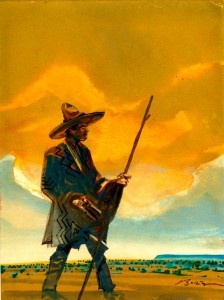 Billy Disguised as a Sheepherder, by Bob Boze Bell
Billy Disguised as a Sheepherder, by Bob Boze BellGardner: That’s what Garrett claims in his 1882 biography of Billy.
Q: Why couldn’t Pat Garrett find a steady place for himself? He seemed to go from one career to another.
Gardner: I don’t know that we’ll ever know the answer to that. I think he encountered some hard luck, a lot of which he brought on himself.
Garrett had a nice federal job as collector of customs at El Paso, Texas, an appointment from President Theodore Roosevelt.
In 1905, Roosevelt was visiting San Antonio for a reunion of his Rough Riders. Garrett was there and brought along a buddy of his, Tom Powers, who owned an El Paso saloon and gambling establishment.
Garrett lied to Roosevelt about Powers, telling the president that Powers was a cattleman. A group photograph was taken with the president that included Garrett and Powers.
Roosevelt found out later about Powers’ reputation as a professional gambler and was quite upset that Garrett had deceived him. When Garrett’s four-year term as collector came to an end eight months later, Roosevelt chose not to reappoint him.
Garrett probably should have remained a lawman – he really excelled at it – but there wasn’t a lot of money to be made in that line of work.
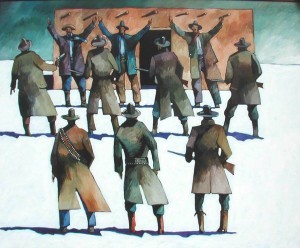
The Arrest of The Kid, by Thom Ross
Q: I believe Billy was destined to become a legend. I can’t explain that. What do you believe?
Gardner: I guess it’s easy for us to look back now and say that, but I don’t think any of his contemporaries saw that coming. They didn’t have the faintest notion their buddy, William Bonney, would become a legend or folk hero.
Q: Billy has always impressed me as being a person who was a lot brighter than the people around him. What do you think?
Gardner: He was brighter in some ways, and one of those ways was in making the people around him think they were brighter! And it got some of them killed.
Q: What are you working on?
Gardner: I’m just putting the finishing touches on a book on Theodore Roosevelt and the Rough Riders for William Morrow/HarperCollins. It’s scheduled to be released on May 10.

Mark (on the right) and Rex Rideout
(Featured image is Pat Garrett – The Making of a Legend* by Don Crowley)
The post Billy The Kid–To Hell on a Fast Horse appeared first on .
November 16, 2015
Comanches and The Captive Boy
Many of the settlers were hard-scrabble poor, spoke no English and had no clue how to farm or ranch, or even how to build a cabin.
They also had no idea Comanche raiders could swoop down on them, murder the grown males, rape the women (and often carry them off to sexual slavery) and carry off many of the children; leaving everything in flames.
Those children were called The Captives.
Most of the children were adopted into the tribe and grew up on the Plains’ vast distances, believing themselves Comanche.
Many times, the captives were never heard from again.
But not always.
The U.S. Army recaptured many captive children, or the Indians themselves brought them to Army posts to trade for Indian captives, or because warriors wanted to take military pressure off their tribe.
That’s what happened to August Shiltz. When he was nine-years-old the Comanche murdered his drunk of a father and raped and killed his sisters and mother.
Tabernacle, a Comanche leader, adopted August, calling him Eka Papi Tuinupu, or Red-headed Boy.
August was Tabernacle’s son until he was sixteen.
Then Col. Mac McKenna’s Fourth Cavalry raided a Comanche village and discovered a white boy: August.
If you want to know what happened after that, you either have to wait a month or so until the novel is published, or you can read the first three chapters and a description of some of the remainder of The Captive Boy by visiting https://kindlescout.amazon.com/p/7378....
The Captive Boy is in the Amazon Scout program, which means if I get enough votes, or nominations, Amazon will offer me a publishing contract.
I can self-publish on Amazon, no matter what, but if Amazon offers me a contract, the company will also promote me and pay me hard cash.
I can live with that.
And I can hardly wait for this issue to be resolved because I have another novel in mind and am itching to write it. This one is also set in the nineteenth century (as most of mine are).
You can contact me with the form on this website, or visit Author: Julia Robb (on Facebook) or just friend me on Facebook.
I also have a Pinterest board titled “Good Books.”
Or, if you have a taste for novels about frontier America, you can read Scalp Mountain, which I published in 2012, or Del Norte, which I published in 2013.

by Michael Goettee
The post Comanches and The Captive Boy appeared first on .
October 5, 2015
Mass Shooters Are Paranoid Schizophrenics
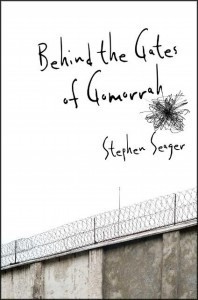
THIS INTERVIEW WAS ORIGINALLY PUBLISHED IN JANUARY, BUT IN LIGHT OF OUR LATEST MASSACRE, (aka mass shooting) at Umpqua Community College in Oregan, I’m running it again .
Dr. Stephen Seager’s memoir, Behind the Gates of Gomorrah: A Year with the Criminally Insane, may be the most important book published in the last ten years.
Seager, a psychiatrist at Napa State (forensic) Hospital, in California, has told America two things it very much needs to know.
One: Mass shooters are primarily paranoid schizophrenics .
Two: Forensic hospitals house violent criminals, including serial killers and child molesters, and those patients are free to mingle with staffers and each other.
Therefore, forensic hospitals are the most dangerous places in this country, both to patients and staffers.
Gomorrah is also a fantastical, almost surreal book that I found hard to put down, rubbing my eyes at 3 a.m.

Stephen Seager
Seager has changed names to protect privacy.
Dr. Seager, thank you for the interview.
Q. You began the book with the character you called Boudreaux (who was hospitalized after walking into the place he worked and gunning down his former co-workers) cornering you and threatening to kill you, calling you a “bloodsucker.”
Then when you briefly talked to him, he snapped back to sanity. He said he had killed his closest friends, and “What kind of a man does that?”
How can the insane snap back to sanity so fast? How does it happen?
A. As it turned out later, Boudreaux suffered from what’s called a “delirium” meaning he was actually medically ill. People who suffer from delirium frequently have florid symptoms of psychosis (think of DT’s – delirium tremens) when people withdraw from alcohol.

Dr. Richard Frishman, a psychiatrist at Napa State Hospital, photographed after he was attacked by a patient.
But delirium can be caused by many things – infections, drug intoxications and withdrawal just to name a few.
Another hallmark symptom of delirium is a rapid shifting from psychosis to normal, which proved to be the case with Boudreaux.
Q. The character you call McCoy is a career criminal, who killed somebody in the hospital. You say he isn’t mentally ill. Then he threatened to kill you because you testified against him in court, to keep him in the hospital.
Is McCoy still at Napa State?
A. Yes. But testifying against your patient and then having to care for them again is a frequent occurrence, certainly not limited to McCoy and I.
Testifying against a patient is the single most dangerous thing a psychiatrist at a state hospital can do.
Q. You say all forensic hospitals are full of violence, patients against staff, and patient against patient. How did the United States put itself in this position?

Napa State staffers, in 2011, protesting violence at the hospital, following the murder of psychiatric technician Donna Gross and the beating of rehabilitation therapist George Anderson
A. During the 1960’s, a series of court decisions seriously restricting the grounds for involuntary admission to a mental hospitals coincided with President Kennedy championing the 1963 “Community Mental Health Centers Act (CMHCA)” which easily passed congress.
The CMHCA was based on the premise that if mental illness could be attacked early and in the community, that chronic mental illness could be prevented and state mental hospitals would no longer be needed.
This sweeping change was not based on a single shred of scientific evidence and, tragically, has proven to be a total disaster.
Based on the wishful thinking of the CMHCA, state mental hospitals were essentially emptied.
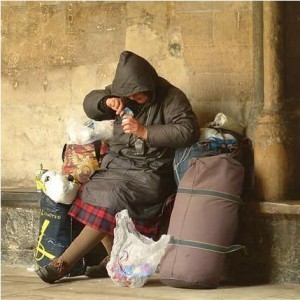 The released patient’s got no better in the community – whether treated early or not – and became the homeless mentally ill that we so often see, sick and dying on the streets of American big cities today.
The released patient’s got no better in the community – whether treated early or not – and became the homeless mentally ill that we so often see, sick and dying on the streets of American big cities today.State mental hospitals with lots of empty beds (then) decided to take in “forensic” patients. Those people who had both committed crimes and were mentally ill.
Specifically to answer your question: few Americans actually care what happens to the mentally ill.
Whether these sick individuals are assaulted in state mental hospitals or whether they die on the streets, doesn’t seem to really much matter.
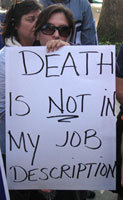
Napa State employees protesting violence at the hospital.
It’s been going on for decades: Did you know about it?
Q. Why have you stayed at Napa?
A. I stayed at Napa because my patients, who absorb most of the abuse and beatings, and the staff – mainly female nurses – really have no voice. No TV cameras, radios, newspapers, documentary film makers or anyone has ever been inside Napa State Hospital.
The BBC has tried. The New York Times has tried, 60 Minutes has tried, and they have all been stonewalled.
Forensic mental hospitals are shrouded in a conspiracy of silence.
My book gives my patients and staff at least one voice. If I had quit, my book would have been easily discounted. But since I’m still there, their voice is still there.
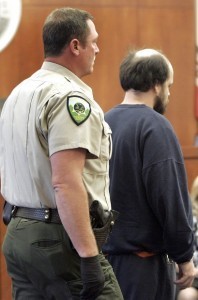
Jess Willard Massey, the Napa State Hospital patient who murdered psychiatric technician Donna Gross, is led out of Napa Superior Court following his 2011 sentencing. Massey was sentenced to 25 years to life.
Q. You say all mass shooters are (primarily) paranoid schizophrenics.
Why doesn’t everyone know about this and why hasn’t law enforcement done something about admitting all paranoid schizophrenics to a hospital?
A. Here’s some figures: 1% of the population everywhere on earth is schizophrenic so in the US that’s 3.25 million people of which maybe 1 million or so are paranoid. There are 50,000 state hospital beds nationally.
The real question is why aren’t they in mandatory out patient treatment?
People know about mass shooters and they know about mental illness but nothing is ever done, which you have noticed. If you figure out why that is, please let me know.
When I said that people don’t care about the mentally ill, I wasn’t kidding.
Q. Is the U.S. more concerned about individual rights than mass murder? Why?
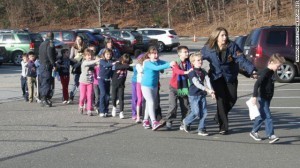
Sandy Hook Elementary, Newtown, Connecticut, 2012
A. For the past fifty years, US courts have been clear that individual “liberty” interests trump pretty much everything else. Including, apparently, mass murders .
For American courts, it’s a bigger deal to force someone to take a shot once a month in the arm against their will than to gun down two dozen first grade students in an elementary school.
Q. What causes paranoid schizophrenia? Brain chemicals? Then why do all paranoid schizophrenics have the same symptoms?
A. Schizophrenia is a medical illness which has a variety of symptoms – as do most illnesses. One of the symptoms is delusions. Delusions are beliefs impervious to reason.
People who have schizophrenia and are primarily delusional are called paranoid schizophrenics.
Schizophrenia is a genetic disorder that produces abnormal brain chemistry. All disease groups have the same symptoms. Like all types of pneumonia pretty much produce fever and cough.
All paranoid schizophrenics have paranoid delusions by definition.

Q. As you noted in the book, many psychologists and psychiatrists do not believe in psychiatric drugs. They deny there’s evidence chemicals in the brain cause mental illness (and some deny there’s any such thing as mental illness).
Yet you believe in their effectiveness?
A. There is no serious debate about the efficacy of modern psychiatric drugs. There are remnant groups – left over from the days of Freudian analysis and the “Anti-Psychiatry Movement” of the 1960’s – who still infect mental health policy, unfortunately at some of the higher government levels.
If I stated that there was any serious doubt about psychiatric medications among the vast majority of psychiatrists and psychologists practicing today, I have given the wrong impression. There are a few well-placed hold outs, but they will pass.
Q. You began one chapter quoting a story in the Bible regarding possession. Do you believe such a thing exists?

Courtyard at Napa State
A. No. But I come from a religious background. I was born in Utah. I am a seventh generation descendant of Mormon pioneers, so I understand that many people do believe this and that’s okay.
What’s not okay is when people try to “exorcise” the demons from the mentally ill or see mental illness as “sin” – as was common in Medieval times.
People once thought pretty much all disease was caused by demons or was sent as a punishment from God.
Unfortunately, this stain tends to linger on the mentally ill, along with many other myths.

Q. You say it’s easy to forget any particular patient is a mass murderer or child molester, and some of your closest friends are mass murderers. Can you tell us more about that?
A. As a physician, you have a natural affinity for the patients entrusted to your care. You can’t help it. My patients and I are locked in together all day almost everyday. I like a lot of them. A lot of them are murderers.
It makes me uncomfortable when I think about it, but that’s the way it is.
 Q. You said a majority of doctors who work in America’s forensic hospitals are foreigners. How do they do at places like Napa? Do they experience it any differently?
Q. You said a majority of doctors who work in America’s forensic hospitals are foreigners. How do they do at places like Napa? Do they experience it any differently?A. I’m not exactly certain how they experience it but they get traumatized by all the violence just like everyone else.
The reason foreign doctors are over represented at state mental hospitals is because most American doctors won’t do it. It’s the same reason inner city clinics are populated by international physicians as well.
Americans don’t care about the mentally ill, so we have out-sourced their care.
Q. You repeatedly talk about the violence (including the doctor who was murdered and the attempted rapes and assaults). How many acts of serious violence have occurred at Napa since you began working there?
A. Hospital administration will admit to 3,000 assaults per year on patients and staff. I think the number is probably higher. I’ve been at Napa for four years so that’s 12,000 assaults.
Q. The character you called McCoy has “Hell” tattooed on his forehead. That seems about right. Can you tell us more about this?
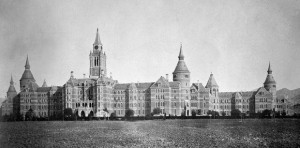
One of the first buildings at Napa State, since demolished.
A. You picked up on the same theme as The New York Times. They entitled my Nov 11th Op/Ed piece,”When Hell is the Other Patients.”
One of the first things a veteran nurse called Napa when I first began working there was, “Thunderdome,” which is about right.
HYPERLINK “https://mail.google.com/mail/u/0/h/t5...” – Show quoted text –
The post Mass Shooters Are Paranoid Schizophrenics appeared first on .
September 15, 2015
Dan O’Brien, Buffalo Ranching and Books

Cheyenne River Ranch: photo by Bonny Fleming
Readers, Dan O’Brien is a Western Renaissance man. He raises buffalo on his Cheyenne River Ranch in South Dakota, and sells his “100% grass fed, non-confined, free-roaming and humanely, field-harvested animals” for meat (no hormones or antibiotics) .
He also writes books and trains hunting falcons.
![meetdan[1]](https://i.gr-assets.com/images/S/compressed.photo.goodreads.com/hostedimages/1442530571i/16247144.jpg)
The ranch is just west of Badlands National Park and North of the Pine Ridge Indian Reservation.
Two of Dan O’Brien’s memoirs are about falcons and ecology (he was one of the prime movers in the restoration of peregrine falcons in the Rocky Mountains in the 1970s and 80s), and they include The Rites of Autumn: A Falconer’s Journey Across the American West (1988) and Equinox: Life, Love, and Birds of Prey (1997).
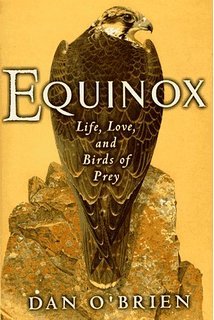 Some of his novels are historical novels exploring Indian/white relations, and they include
The Contract Surgeon
and
The Indian Agent
.
Some of his novels are historical novels exploring Indian/white relations, and they include
The Contract Surgeon
and
The Indian Agent
.Buffalo for the Broken Heart: Restoring Life to a Black Hills Ranch (published 2001), and Wild Idea: Buffalo and Family in a Difficult Land (2014), are his ranching memoirs.
I found Buffalo for the Broken Heart particularly fascinating, because it’s about converting a cattle ranch to a buffalo ranch.
His other novels include The Spirit of the Hills, In the Center of the Nation, Brendan Prairie and Stolen Horses.
Hi Dan: How many sections, or acres, do you have on the Cheyenne River Ranch?

Dan O’Brien: The Cheyenne River ranch is a unique property. The deeded land is not large – about 3,000 acres. But the ranch is surrounded by the Buffalo Gap National Grasslands which is a huge piece of federal land administered by the US Forest Service. This is public land that belongs to all Americans.
 We lease about 20,000 acres of it where we run our buffalo in the wintertime. We also help manage a partner’s ranch which about 10 miles away and even larger.
We lease about 20,000 acres of it where we run our buffalo in the wintertime. We also help manage a partner’s ranch which about 10 miles away and even larger.It too is a combination of deeded and leased government land.
Q: I know you’ve written you got into the buffalo business in order to help reintroduce buffalo into the West, and show other buffalo ranchers they could raise grass-fed buffalo and not put the animals in feedlots, plus help with Western ecology, but if you had it to do over, would you have gotten in the buffalo business?
O’Brien: That is a damned good question. I ask myself that often and can only answer it by saying that all of us who are paying attention know that humans have created a crisis that dwarfs all other crisis, for all time.
If you care about what we have done, and continue to do, and you are not a coward and a quitter, you have to do something.

I am a Great Plains guy. I would not be any good at battling the forces that are ruining the oceans or the rain forests. I really have had no choice but to pitch in for what I hold dear and know something about.
Q: While reading your latest memoir, Wild Idea , I suspected you see buffalo in spiritual terms. Can you tell us more about that?
O’Brien: Yes, I see buffalo in spiritual terms, but I see most things in
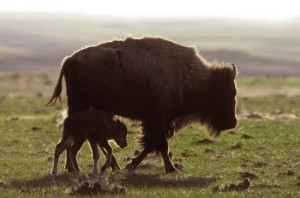 spiritual terms. I suppose that I am a Pantheist but I am not all touchy feely about any of it.
spiritual terms. I suppose that I am a Pantheist but I am not all touchy feely about any of it. To me the spiritual is really a kind of practicality. Buffalo and everything else that makes up an ecosystem is holy – regarding it as such is very practical.
Q: I was fascinated with both your ranch
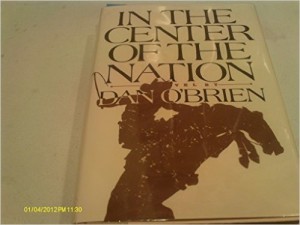 memoirs. They were so detailed. Did you base them on a journal you kept?
memoirs. They were so detailed. Did you base them on a journal you kept?O’Brien: Sadly, I am not a journaler. I have tried and a few times have begun – say on the first of January of some years – in earnest. I start out with detailed descriptions of my days and impressions. But by about the fifth of the month I am down to entries such as – “Snowed today. It’s real cold.”
I give up by January tenth.
Finally, for me, journaling is just another thing to do. It ends up being a chore, or worse yet, an excuse to NOT write. And I’ve got enough excuses.

Buffalo harvesting truck
Q: It seems while you feel deeply for buffalo and their connection with the land, it doesn’t bother you to kill them for meat. Why is that?
O’Brien: We are humans and we should not be freaked out about death. Of course our antiseptic culture creates revulsion for death but we all know that it is a fact. We – people, buffalo, and everything else – die. We have no control over that.
We can have some control about is HOW we die.
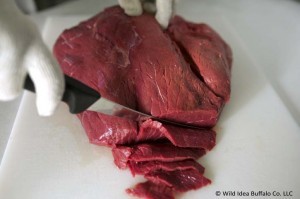
Buffalo meat
I have spent the last fifteen years of my life trying to give buffalo a dignified death that beats the alternative.
They seem to understand that, much better than some people
Q: Why do you enjoy training falcons and hunting with them?
O’Brien: Falconry is my golf. It is an active form of bird watching. Nothing passive about going out in the wind and grasslands and trying to orchestrate a situation where you get to watch what happens out of human sight every second of every day.
It is a metaphor for becoming a participant in life and gets my ass off the couch.

Q: You mentioned in both your ranch memoirs you are attempting to reintroduce native grasses. How is that going?
O’Brien: Reintroduction of native grasses is a very difficult job. Most of the grasses that made up the bedrock of the Great Plains are perennial grasses in a biodiverse mix of plants that take turns taking advantage of the meteorological variations from year to year.
This should be understood in its simplest form – those grasses were meant to be part of an ecosystem that is forever.

But when they are plowed up, or destroyed by over grazing, they cease to be. They are usually replaced by a few annual plants that have their own strategies for survival.
Once humans choose to encourage these invaders the perennial natives are put at a disadvantage. To reintroduce them is very expensive and very risky. (Success depends on weather and weather on the Great Plains is dicey at best.)
Still, we are seeing progress.
 Our old farm fields where the native grasses were expatriated are showing signs of recovery but I will never see those fields the way they were when homesteaders brought plows into this county.
Our old farm fields where the native grasses were expatriated are showing signs of recovery but I will never see those fields the way they were when homesteaders brought plows into this county.Q: How is your friend Erney Hersman, who had the stroke?
O’Brien: Erney has slowed down greatly since his stroke but he is still alive and he is still my friend. He is a big reason that I have been able to have the life I have had. If it weren’t for him I could not leave this place.
He still takes care of the falcons and the dogs, though he now spends most of his time indoors watching Gunsmoke reruns.

Scenes from the ranch, Dan on the left, wife Jill on the right and Ernie and Henry the dog in the middle
Q: You’re a busy guy. How do you run the ranch and the meat business, plus write, plus care for and train falcons?
O’Brien: I really don’t have a good answer for that one. I just get up early and try to go all day long. I think the balance between outdoor responsibilities and the desk job of writing aids productivity. Somehow they feed each other.
Q: How is your business doing?

Dan with a rescued falcon
O’Brien: The business is a new adventure for me. I am about as non-entrepreneurial as a guy can be. But I am learning. Wild idea Buffalo Co. is not a big money maker but it was never intended to be. We put everything back into the business and the land.
The business is growing. So I guess we are doing all right.

Q. I have the impression Americans feel injured by the slaughter of the buffalo and the loss of the wild in our country; that buffalo are our symbol for wholeness, which we are seeking. Do you agree?
O’Brien: Yes, I agree. The buffalo is the icon of what it means to be an American. Strength, endurance, freedom of movement, purity of purpose.
http://wildideabuffalo.com
The post Dan O’Brien, Buffalo Ranching and Books appeared first on .
August 24, 2015
Texas’ Southern Great Plains: The Last Picture Show
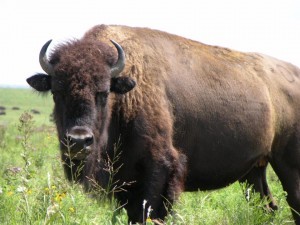 This article was originally published in The Texas Observer magazine
This article was originally published in The Texas Observer magazine Before white men fought their way from the Sabine River to the Big Bend, the Texas Southern Great Plains was covered with bluestem grass so tall it could tickle a horse’s belly and buffalo herds migrating across the plains sounded like the growl of distant thunder.
But the buffalo were destroyed, the Comanche and Kiowa who thrived on those herds were penned up on Oklahoma reservations, railroad cars replaced cattle drives, and men whose faces resembled red-rock canyons mourned. The times had shrunk, and so had they.
But something valuable took the frontier’s place in Texas hearts: our small towns. We became tee-totaling Baptists, hymn-singing Methodists, under-the-bright-lights Friday night football fanatics, and irrigated, Alamo-revering Texans.
This is the irony of Texas. We destroyed the plains to build the towns that are now disappearing as well. Thanks to dwindling water supplies, and farm and ranch mechanization, many of the small towns flung between Abilene, Amarillo, and El Paso are vanishing like dust on the wind.

If rural counties and small towns keep losing people at the current pace, by 2040 West Texas and the Panhandle will be as empty as they were in the mid-19th century. Small-town Texas is making a painful transition from real thing to airbrushed memory.
One chapter in the story is being written 25 miles southwest of Wichita Falls in Archer City, the place native son Larry McMurtry made synonymous with a small town’s passage to nowhere in his novel The Last Picture Show.
Archer City’s fate these days could either be seen as a warning on how towns should not react to economic hard times, or a paean to enduring values.
When The Last Picture Show movie was filmed in 1971, Archer City was cast as a semi-ghost town. Most scenes featured two or three people, and no more than 30 appeared in the entire movie.
But the story was set in the 1950s, when Archer City and towns like it were the biggest and most prosperous they had ever been.
Now it is rapidly becoming the ghost town the movie portrays, with the full consent of many Archer residents.
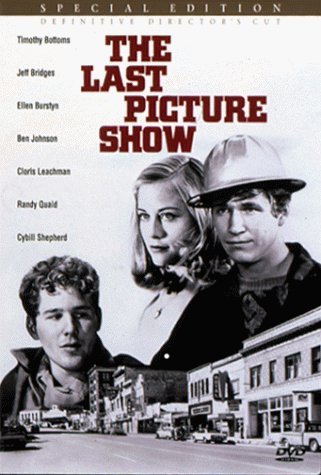 When I saw it last fall, boarded-up businesses surrounded the 1892 sandstone courthouse dozing in the middle of the square, under a big blue sky. There was little traffic to stop at the red light blinking on Main Street. The town’s population has fallen with every census since 1960, and about 1,800 people are left.
When I saw it last fall, boarded-up businesses surrounded the 1892 sandstone courthouse dozing in the middle of the square, under a big blue sky. There was little traffic to stop at the red light blinking on Main Street. The town’s population has fallen with every census since 1960, and about 1,800 people are left.Thirty years ago Archer had a hardware store, an appliance store, two department stores, three sit-down restaurants, two grocery stores, seven full-service gas stations, a full-time doctor and hospital, a lumber yard, and a full-service dry cleaners, according to Archer County Judge Gary Beesinger.
Almost all are gone. One of the two remaining sit-down restaurants is a Dairy Queen, and there are three sets of gas pumps, but no full service.
Jobs in town open up only when someone retires or dies, one resident says, so many folks commute to Wichita Falls for work.
McMurtry still owns four rare and used bookstores, all in what’s left of downtown, but that presence does not make everyone happy.
Over the years some people–like Beesinger and businessman Abby Abernathy–have come to believe that what Archer City really needs is to be saved from itself. They have failed to win over the town with that argument.
Abernathy, who grew up on his family’s 8,000-acre Seven Bar Ranch, was in his 20s when he began urging Archer City’s tiny population to try enticing tourists to town, to fill the gaps opening in its failing ranch-and oil-based economy. In his late 30s, he ram-rodded the reconstruction of The Royal Theater (the famed last picture show) and helped create a foundation to oversee its little-theater performances, supper club, and a “Texasville Opry.” In 2002, when he was 40, he became the foundation’s executive director.
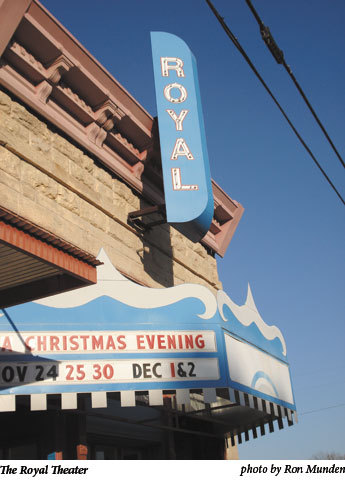 Two years later, he gave up and moved to Wichita Falls.
Two years later, he gave up and moved to Wichita Falls.“I did everything I could do,” Abernathy says. “I gave them all I had. … and maybe it was just that I was barking up the wrong tree. Maybe if I had spent the same amount of time developing industry … (things would be different).
“But really, I don’t think it would have mattered. There’s some really good people here, but many are suspicious of change.”
Both Abernathy and Beesinger say they envisioned using the theater, the square’s 19th century buildings (which they hoped would include healthy tourist-oriented businesses), and McMurtry’s book stores to draw people from all over the nation.
Abernathy says promoting the bookstores wasn’t popular because many Archer residents disdain them, and some dislike McMurtry himself.
“The mentality of the city is that Larry is buying up all the buildings and filling them with books, and what do we need books for?” Abernathy says. “They don’t understand what he created, which is a one-of-a-kind, one of the largest collections of rare and used books in the Southwest.”
Beesinger wrote a column in the Archer County News for several years extolling economic development through tourism, arguing that tourists would buy gas, eat at the restaurants, buy books, and stay at the Spur or the Lonesome Dove Inn. But Beesinger was discouraged by the business community’s lack of support and felt he had talked economic development to death. So he changed the column’s focus.
“It’s the same old story. Change is hard to accept, and the fear that comes with change,” Beesinger says, adding that the only things that keeps Archer City from disappearing are the bookstores, the Royal, which has a healthy audience, and the town’s commuters.
Mary Webb, one of McMurtry’s close friends and the proprietor of the Lonesome Dove Inn, says she senses jealousy towards McMurtry. When an Austin theater chain, the Alamo Draft House, brought a giant movie screen to town in 2005 to show The Last Picture Show near the Royal, few locals were among the crowd drawn mainly from Dallas, Austin, Wichita Falls, and Houston.

McMurtry
But McMurtry himself disagrees with Abernathy and Beesinger, calling them “utopians.” He doesn’t think his bookstores will attract more tourists to Archer City, because tourists don’t buy books. If tourists come at all, he says, it’s simply “to see where The Last Picture Show was made.”
What supports “Booked Up Inc.” is not tourists, McMurtry says, but book lovers who come to Archer City to explore his stores, and only to explore the stores. Tour buses disgorge passengers at his bookstores who “are more trouble than they’re worth” because they “damage the stock and get things out of place. Buses are not a guarantee of book sales.,” he says. They also plug up the store’s bathroom.
McMurtry says the town’s ambivalence toward him hasn’t hurt his feelings. He’s spent only three or four nights in Archer City in the past year, and “it would be just as true to say I rejected” the town.
After all, McMurtry says after leaving in the 1950s, he didn’t return to live in Archer for 44 years, when he came home to get his bookstores started because he couldn’t afford to house them in big cities.
“I’m a polarizing figure. I don’t want to be the focus of any town. I don’t want to be the person everybody reacts to. They need another villain, or another hero,” says McMurtry, who now lives in Tucson, among other places.
Undiscouraged by attitudes about McMurtry, Abernathy and Beesinger, in 2002, helped lead the drive for a successful election permitting the town government to use some of its sales tax revenue to fund the Archer City Growth & Development Corp. Voters were told the money would be used to beautify downtown and develop the historic district. It was impossible, supporters argued, to draw healthy businesses—and therefore tourists—to the square without fixing up the downtown buildings.
Things did not go as planned. Instead of spending money on the historic district, the development board used it to attract industry. Only now have board members achieved their first success. The board is providing loans to an aluminum-extrusion plant that will hire five full-time employees, according to the Economic Development board’s volunteer president, Rob Starnes, a 70-year-old retired businessman. He says he hopes more employees will be hired eventually in the future.
Town officials have also agreed to give the plant a tax break for two years. The board says it is trying to give the plant owners an incentive for hiring more full-time employees.
Tourism is “a shot in the dark,” Starnes says. “You don’t know what you’re going to attract, or anything else.” Tourists would “be a benefit, but we are limited what we can do, and we wanted to put money into what we were sure was employment.”
Those who support tourism as a way to revive Archer City “have a point … but what else does Archer City have besides bookstores? You have to have something they want to come and see,” he says.
Starnes says the board has also helped a hog farm expand by allowing the company that owns it to sell bonds through the economic development corporation.
Archer City’s residents are courteous. They acknowledge their town has problems. I walked into the Wildcat Cafe at 6 a.m. on a cold morning. Customers were having their first cups of coffee, and those soft-spoken men did everything but tip their hats and say, “Howdy ma’am.” (The ratio of men to women in the cafe was about 30-to-1 both mornings I was there). That courtesy conceals firm opinions, even a certain amount of despair.
Jerry Morrison, 60, an ex-ranch foreman who says he now takes care of cattle for local landowners, complains the Western values he grew up with are already gone. His son and grandson shot a deer at their barnyard, which is “against the rules of this country.”
“Ranchers used to work together, but they aren’t doing that anymore,” he says, and they are also subdividing their land and selling it, or leasing it to hunters and developers. “Hell yes,” Archer City has a future, he says, “because Wichita Falls is growing down here.” That same growth is “ruining the country,” he says. “They call it a good thing. They call it progress. I ain’t much on progress.”
Clay Reid, 39, who runs Hawley Ranch, agrees. Ranchers are selling their land off, and half the people he sees in Archer City are “rude” strangers. Archer City’s economy has recently improved because the state’s oil industry is booming, says Wayne Browning, 64, a partner in Big Giant, an oil and gas drilling company. Despite the improvement for his business, he says Archer’s older residents are dying and the younger ones are leaving.
Carlton Deen, 64, owner of Deen Drilling and McMurtry’s brother-in-law, believes Archer City has a future if the government doesn’t get in the way, but as far as tourism is concerned, he says, “Maybe we don’t want them.”
There you have it. Archer City shrinks each time a resident dies, or a high school graduate leaves for the big city.
One day, if nothing changes, Archer City will look exactly like it does in The Last Picture Show: a ghost town. In time, most Texas small towns west and north of the Trinity River will follow suit.
It doesn’t necessarily have to be that way. Many Texas towns are turning to tourism, and some have been successful.
Canadian, a Panhandle town near the Oklahoma border, is thriving on the tourist trade, touting its history and even luring tourists to see its prairie chickens.
But Archer’s cowboys and businessmen may have a point. If Archer, and other Texas towns, succeed in attracting tourists, the towns’ characters could be forever changed. It’s a big leap from ranching in the big sky country to antiques and birders on main street.
Either way, deep in the heart of Texas may be disappearing.
When it’s gone, it won’t come back.
The post Texas’ Southern Great Plains: The Last Picture Show appeared first on .
Who Were Those Masked Men?
Here’s my most vivid memory from Midland: I am a teenager, my nose pressed flat to the glass to better see a display case at the Midland County Historical Museum. The case and the museum are in the county library’s dark basement. Yet the object of my fascination, six plaster of Paris death masks, glow enticingly with an aura of violence and decay.
Even then, as an Old West enthusiast, I know all about the desperados whose features supposedly formed the masks: Jesse James, Wild Bill Hickok, Bill Dalton, Butch Cassidy, Clay Allison and Bob Ford-“the dirty little coward who shot Mr. Howard and laid poor Jesse [James] in his grave.”
Those masks have haunted my dreams since the mid-60s, so much so that I recently returned to stare at them again. The masks, I discovered, are exactly the same, and yet everything is different.
Jesse’s face is serene, as if he’s sleeping. The most infamous outlaw in American history looks more at rest than he probably ever looked in life. He began riding with Bloody Bill Anderson’s Confederate guerillas when he was 16, robbing banks and trains almost as soon as Lee surrendered at Appomattox. He didn’t stop until Ford murdered him in St. Joseph, Mo., in 1882.
I see Jesse’s assassin, Bob Ford. His face appears appropriately anguished-his broad lips pulled back in a grimace. Ford was killed almost the same way he murdered Jesse, by a man who didn’t give him a chance, instead catching him by surprise and filling him with lead from a double-barreled, sawed-off shotgun.
Wild Bill’s features are also serene. He never knew what hit him. The auburn-haired ex-lawman, former Union Army scout, Indian fighter and showman, was shot in the back of the head, in 1876, while playing poker in a Deadwood, S.D., saloon. Hickok, only 39, never knew Jack McCall was creeping up behind him. “Take that,” McCall said, according to a Deadwood newspaper, and fired. McCall later said he was avenging a brother that Hickok killed while he was marshal in Abilene, Kansas.
Hickok’s brains may have splattered on that card table, but his memory lived on. His 1865 shootout with David Tutt in Springfield, Mo., was reportedly the first recorded example of a classic Western gunfight: two men walking toward each other in the middle of a street, blasting away. They were about 50 feet apart when both fired. Tutt missed. Hickok drilled Tutt through the heart.
The mask of Robert Leroy Parker (alias Butch Cassidy) is grotesque. If this really is Parker, he was no Paul Newman. The mask’s nose is extremely broad and uneven, the lips unnaturally wide. The area under the right eye is seemingly filled with scar tissue or swelling. Cassidy and sidekick Harry Longabaugh (the Sundance Kid) achieved fame as leaders of the “Hole-In-The-Wall” gang, named after their Wyoming hideout, and more fame later in the movie that bore their names.
Most experts believe Cassidy and the kid were killed in San Vicente, Bolivia, in 1908, after they held up a mule train carrying the Aramayo Mine payroll. But as with much of Western lore, where fact became myth almost immediately, there is a sliver of doubt. In the 1970s, Cassidy’s sister claimed he came home and lived in the Northwest until his (natural) death. His mask depicts a middle-aged man so ugly, it’s hard to believe the law never caught him.
Clay Allison’s mask is also inexplicably serene. He died in Pecos County, Texas, in 1887, falling off a hay wagon, the wheels of which ran over his neck. Allison-who called himself “a shootist”-is the only one among the six masks who could be considered a Texan. He was born in Tennessee in 1840, fought with Confederate Gen. Nathan Bedford Forrest’s cavalry, then ranched in Texas and New Mexico when he wasn’t killing folks. At one point, Allison bragged he had never killed a man who “didn’t need killing.” A yellowed piece of paper pasted to the mask describes Allison as a bad man “but not a murderer.”
Bank robber Bill Dalton’s tongue protrudes from his lips in his mask. In better days, Dalton belonged to the Dalton-Younger gang, filled with his brothers and cousins. In 1894, he organized another gang (his brothers had been killed or sent to prison), and it robbed the First National Bank in Longview, Texas. The gang promised to “take East Texas by storm.” Instead, lawmen killed one of the gang outside the bank and later found Dalton when he spent some of his ill-gotten gains. They gunned him down as he tried to escape. Not the brightest outlaw, Dalton sent a note to Longview bank officials warning them the bank would be robbed, and helpfully provided dates.
Today the once-dark museum is in a bright library annex. A few phone calls and an Internet search quickly raise questions about the authenticity of the masks. The museum’s 94-year-old curator, Nancy McKinley, is convinced they are genuine despite lack of solid proof of their origins. Miss McKinley, who has been Midland County’s Historical Society president (and its only president) for 50 years, says a society member bought the masks about 1960, or 1961, from a Chicago antiques dealer. “It sure does look like them. When you put them against their pictures, you can see the resemblance,” she says.
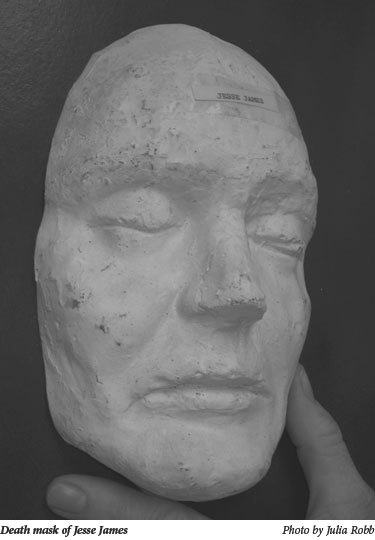
Well … not so much. It’s easy to see that Wild Bill could not really have been the (helpless) model for his supposed death mask. Hickok had an oval chin, a long, oval face, a hooked nose, and wide, flaring nostrils. The mask has a square chin and differently shaped nose and nostrils. While Jesse James’ mask might compare with his photo, his killer Bill Ford’s visage looks nothing like the death grimace at the museum. So it goes through the lot.
Six Wild West experts say they doubt the masks are genuine, or that they could not possibly be genuine. Tom Goodrich, author of 10 nonfiction books, five about the American West, says he has extensively researched Old West characters, but has never read that plaster of Paris was used on the dead faces of Hickok, James, Ford, Allison, Dalton, or Cassidy. “That doesn’t mean there weren’t such masks, simply that it is not well known,” he says.
Also, since nobody knows when, how or where Cassidy died, “doesn’t that cast suspicion on all the other purported masks?” Goodrich asks.
Liz Murphy, historic interpreter for the Jesse James Farm and Museum, in Kearney, Mo., says she believes James experts would know if a James death mask had been made, or “even if a prominent fake existed … just the mention of Jesse’s name will bring in dollars.”
Miss McKinley-a loyal daughter of Texas who wears the state flag on her earrings and flies it on her 1976, yellow Ford Elite-says the masks have never fascinated her, though many museum visitors have been caught in their grip.
“They just want to know if the masks are real, and we say that’s what we were told,” she says, adding that children are particularly able to relate. “They know about Jesse James getting shot in the back, and they say, ‘Oh, poor guy.’ They’ve never seen a death mask, they tell me.”
Most people are equally fascinated by the museum’s shrunken head, Miss McKinley says, and the collection of items a local butcher found through the years in chicken gizzards; nails, screws, marbles, bullets, nails, bottle caps, and needles, among others. The gizzard trash is her personal favorite.
The masks are now in storage to make way for a World War II exhibit. But they can be taken out for visitors when the museum is open, three days a week, from 2 p.m. until 5 p.m., when Miss McKinley is able to work.
I’m considerably older than a teenager today, and even without the knowledge that they are probably fake, the masks have lost their luster. When I was 16, a bad man’s fame and deadliness seemed glamorous. I stared for hours at a time at the masks, drawn to the bad ones, the men who had been wanted, had shot it out with the law, been chased, and, for a time, escaped. They were daring. Now I know there is more value in creation than destruction. A life filled with goodness holds more romance for me.
When I saw the masks in June, I was able to touch Bill Dalton’s tongue and Jesse’s eyes. I didn’t feel a thing.

The post Who Were Those Masked Men? appeared first on .
August 18, 2015
Bob Boze Bell and His True West
READERS, Bob Boze Bell is the owner and executive editor of True West magazine, which is about all things Old West, plus he’s a funny guy, writer and artist.
Bob (Boze is a nickname) lives in Cave Creek, Arizona, where the magazine offices are located.
Here’s some of the things he’s written about his early life.
October, 1957: While watching the TV show “Wyatt Earp,”  Bell’s grandmother, Louise Guess Swafford, remarks that the real Wyatt Earp was the biggest jerk who ever walked the West. Struck by the credibility gap between the TV show and his ranching family grandmother (who actually lived on a ranch near Tombstone at the turn of the century), little Robert makes a vow to someday find out the “truth.”
Bell’s grandmother, Louise Guess Swafford, remarks that the real Wyatt Earp was the biggest jerk who ever walked the West. Struck by the credibility gap between the TV show and his ranching family grandmother (who actually lived on a ranch near Tombstone at the turn of the century), little Robert makes a vow to someday find out the “truth.”
April, 1964: The high school baseball coach calls him “Bozo” for running backwards to first and second base in a game with Needles, California. Cruel team mates pick up on this, and shorten the moniker to Boze. It sticks.
May, 1964: Loses virginity near White Cliffs, Arizona. Recalling the important details of this emotional event, Boze remembers “it was in a ’62 Rambler.”
 October, 1992: After no legitimate publishers take the bait, Bell self-publishes his first Old West opus, The Illustrated Life & Times of Billy the Kid. The printing bill is $17,000. Bell borrows $5,000 from his Dad (repaying his patient father $200 a month until the millennium).
October, 1992: After no legitimate publishers take the bait, Bell self-publishes his first Old West opus, The Illustrated Life & Times of Billy the Kid. The printing bill is $17,000. Bell borrows $5,000 from his Dad (repaying his patient father $200 a month until the millennium).
October, 1993: Bell publishes his second book, The Illustrated Life & Times of Wyatt Earp. The printing bill is $27,000. Bell borrows $3,000 from his mother-in-law…It sells out in 10 months and a second edition has also sold out, and a third (And a fourth).
July 12, 1999: Boze and longtime friend Bob McCubbin make a down payment on True West magazine and plan to move the operation to Arizona in November. 
November 1, 1999: Three Mayflower trucks pull up to the new True West offices behind Frontier Town in Cave Creek and demand a cashier’s check for $12,920.40 before they’ll unload. Bob McCubbin dubs the premises “Clantonville” and a new era in the history of the West begins.
(Readers, Bob painted all the art in this blog).
Welcome Bob, you’ve been fascinated with the American West most of your life, according to your website. You paint the Old West and its historical figures, you write about them and you own a magazine devoted to these subjects. Why are you fascinated?
A. I have always been fascinated about the myth and legends of the West vs. what REALLY happened. There are so many layers of myth it’s hard to see through the fog, but when you occasionally see a glimpse of what it was really like in those distant days, it’s a wonderful thing.
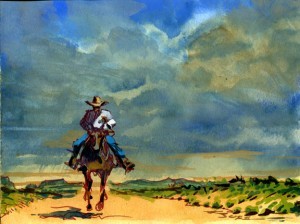 The myth says that Billy the Kid killed 21 men, one for every year of his life. How’d you like to be with the Kid on New Year’s Eve and he hadn’t met his quota? In reality Billy killed maybe four or five. We don’t know the exact number because he was in fights where there were multiple shooters and we don’t know who actually shot who.
The myth says that Billy the Kid killed 21 men, one for every year of his life. How’d you like to be with the Kid on New Year’s Eve and he hadn’t met his quota? In reality Billy killed maybe four or five. We don’t know the exact number because he was in fights where there were multiple shooters and we don’t know who actually shot who.
Q. I’ve noticed a significant number of people seem drawn to the American Indian, to cowboy paintings and the West and its landscapes in general. Do you think it’s because they’re unhappy with our stressful culture and its pressures, and the disappearance of the natural world?
A. Well, I think some people are disappointed with the modern world and want to escape to a simpler time, but I’m not one of them. I really like air conditioning and Led Zeppelin, to name but two things I would not like to be without.
Q. You are a gifted artist; original and convincing. I love your “Billy the Kid’s Winter” series; such as “Almost Home,” and all the winter scenes. (You paint great snow). Why did you paint them? Did you start the series out with Billy in mind? 
A. I have been experimenting with something I call “graphic cinema” which is an attempt to do a movie on paper. We ran the Billy in snow series as a doubletruck several years ago and I loved doing snow scenes. In fact, I love weather in movies. My favorite Western is McCabe & Mrs. Miller and one of the main reasons is that the weather is a character in the film. I also love the rain in Two Lane Blacktop. Oh, and the snow in It’s A Wonderful Life.
Q. What does Billy the Kid mean to you? How do you think he saw himself?

Billy Disguised as a Sheepherder
A. Billy the Kid will always be the fantasy of who I wanted to be as a nine-year-old and as a 69-year-old (okay, I fudged, I’m only 68, but I couldn’t resist). I doubt that the real Billy knew he would become such an icon, but I have a hunch he’d have a good laugh about it.
Billy is the All-American Boy and a cold blooded killer. Those two personality traits do not match, but they create sparks, sort of like a car battery. It is very powerful and endures to this day.
Q. In the paintings, I see a Billy who is at home in the natural world, alone but not isolated, a man at peace with his environment. Is that how you see it?
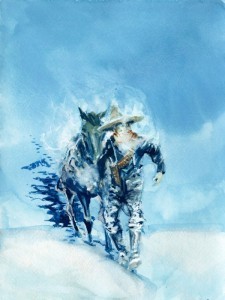 A. Someone once said when we say we love winter we really mean we love the proof against it. That is where I stand. I love to snuggle in my adobe, next to the fireplace, drinking brandy laced coffee and telling tall tales, but I don’t really want to ride across the San Pedro with ice flows crunching by.
A. Someone once said when we say we love winter we really mean we love the proof against it. That is where I stand. I love to snuggle in my adobe, next to the fireplace, drinking brandy laced coffee and telling tall tales, but I don’t really want to ride across the San Pedro with ice flows crunching by.
Q. You and Thom Ross both seem fascinated with the Earps and Doc Holliday. What accounts for your fascination?
A. For me, when my grandmother said, “Wyatt Earp was the biggest jerk who ever walked the West,” I was hooked. How could someone so cool—he had that Colt with the barrel that reached clear to the ground—be a jerk? That is the moment I knew I had to find out WHO WERE these guys?!
On many levels I have discovered Wyatt Earp’s true life and I must say he was a flawed man, to say the least, but I still like him. Hell, I probably like him even more. He’s human and he had sand.
Q. Jeff Guinn, who I interviewed a few months ago, does not believe Tom McLaury was armed during the Gunfight. Do you agree? 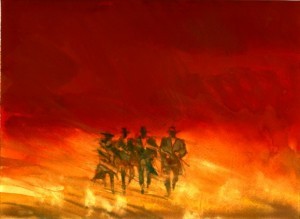
A. Yes, I agree with Jeff. Why would an armed man be reaching over his bucking horse, trying to retrieve his Winchester, when he was shot by Doc Holliday? On the other hand, Wyatt Earp claimed it was Tommy (his family called him Tommy) who fired first to open the fight. Not sure why Wyatt blames him, but I have a hunch it was to cover for Holliday’s drunken aggression.
Q. What is Mickey Free to you?
A. Mickey Free is the future of America. I am dying to do a sequence of the tattered scout at the White House with the staff mocking him as a mongrel and smirking, “If that’s the future of America, help us all.” Of course, the little captivo was exactly who America is today.
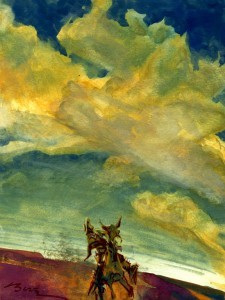
Mickey Free Clouds
His real name was Felix Ward and he was kidnapped by Apaches and it was his capture that led to the Bascom Affair at Apache Pass that led to the longest war in U.S. history between the Apaches and the U.S. Army. Thousands died and for over 25 years the entire Southwest was in turmoil, all because of this boy who grew up to be Mickey Free.
In the end, he chose the Apaches and he is the face of America in our time. Someone who is multi-ethnic and a bit of a mutt, but a lovable one.
Al Sieber said of Mickey, “He’s half Apache, half Mexican and all son of a bitch.”
Q. How is the magazine doing? Your website said you’re in the process of an aggressive expansion. What does that mean? 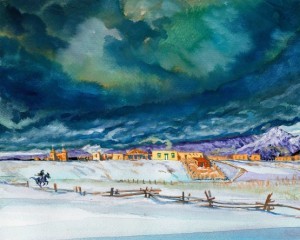
A. True West magazine continues to evolve and now we are in the process of expanding our reach digitally, online. Thanks to Darren Jensen, our Facebook page is breaking new ground every day with images snagging hundreds of thousands of views.
We have never had a bigger audience with more reach than today. And all of this data helps the print magazine because we see very clearly what our readers want. When a photo of Olive Oatman’s tattooed visage snags a half-million views, we know that her striking face will work in the magazine and so, that is why we ran her on the cover last December (2014). 
The issue sold very well.
Now we peruse and study our online numbers every day. It’s a gold mine really. People say print is dead, but it’s not dead, it’s just evolving into a much bigger arena. I’ve never been more excited about our prospects.
Q. What are you working on?
A. I’m up to my eyebrows on a cover story, “Wyatt Earp In Hollywood: The Untold Story.” It’s about how Wyatt Earp got ripped off by outlaws in the last outlaw town. If I have my way, expect a book and a documentary next year.

Billy Hunkers Down
http://www.truewestmagazine.com/jcont...
The post Bob Boze Bell and His True West appeared first on .





